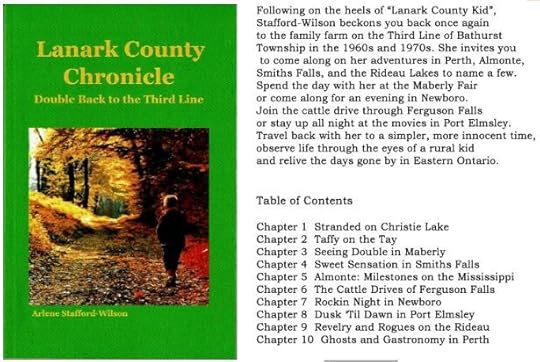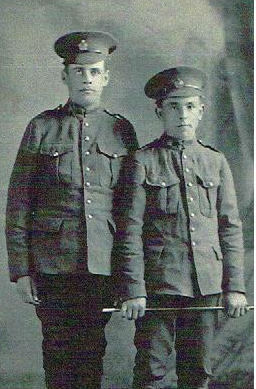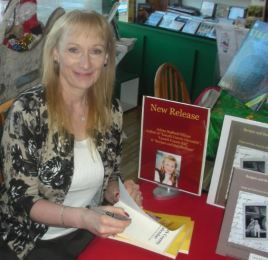Arlene Stafford-Wilson's Blog, page 15
November 3, 2023
War Brides
On November 12, 1986, “The Perth Courier” published an article by Michael Taylor, titled, “War Brides: The Unsung Heroines of War.” The article featured three local war brides, and their stories: Anne O’Neil, Audrey Montgomery, and Peggy Young.


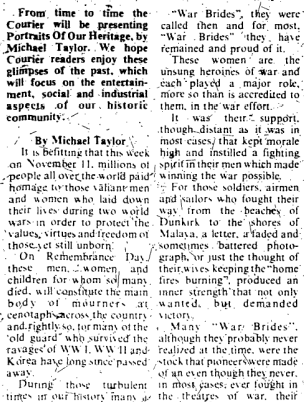

“When following their husbands who were usually shipped home before them, these women were transported to a land known only to them through school books and the ramblings of homesick young men.”
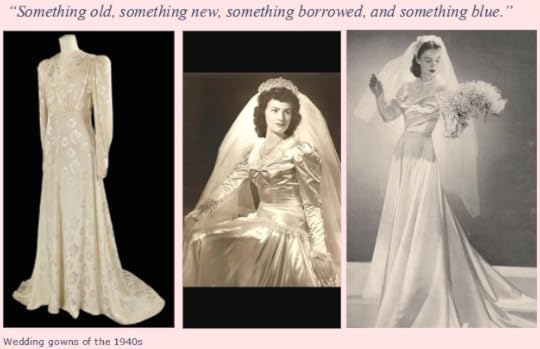
Anne O’Neil (1927-1994)
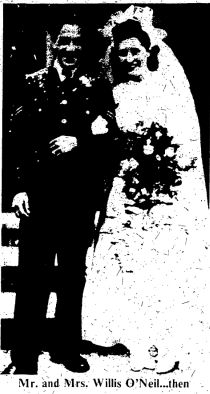
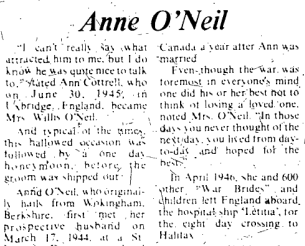
Anne Cottrell (1927-1994) hailed from Wokingham, Berkshire, England, and first met Willis O’Neil on March 17, 1944 at a St. Patrick’s Day party, at a local pub in Uxbridge.
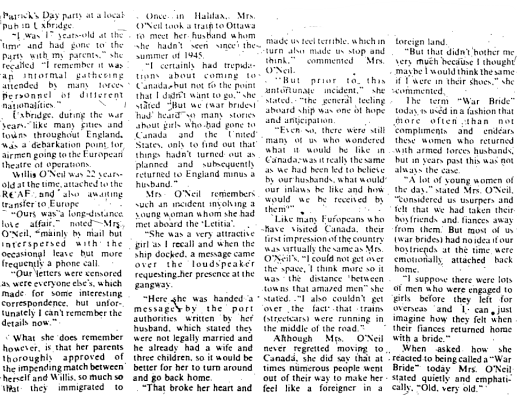
Willis Orval O’Neil (1921- 2002) served with the R.C.A.F. #415 Squadron and was a proud father to: Sharon, Terry, Debbie, Keith, Colleen, Stephen, Erin, Jimmy, Kevin, Michael, Randy, and brother to Melvin, Jackie, Darlene, Audrey, Elroy, Donnie, Doug and Hilda.
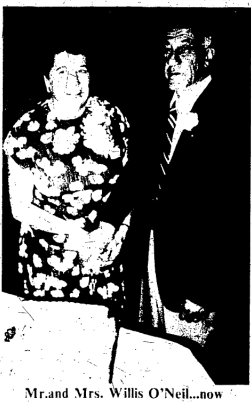
Audrey Montgomery (1926-2016)
“Those Canadians are a scruffy lot, I remember saying to a friend in 1942, shortly after a contingent of soldiers arrived in my home town of Crawley Down, Sussex, England.”
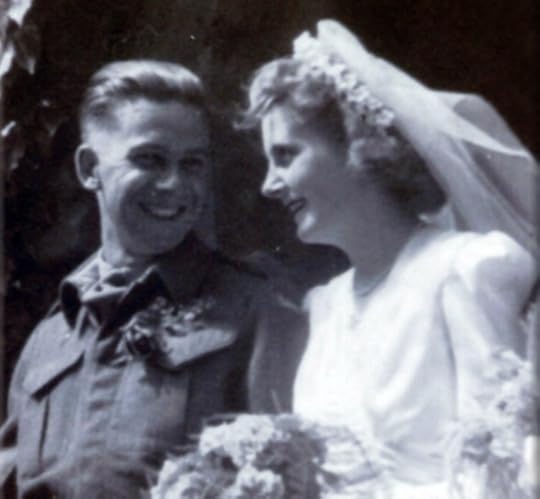
Audrey Elsie (Riley) Montgomery was sister to Dulcie (Riley) Preston and Barry, Jim, Kenneth and Tony Riley, and she and her husband, Alex, had two daughters: Heather and Dawn.
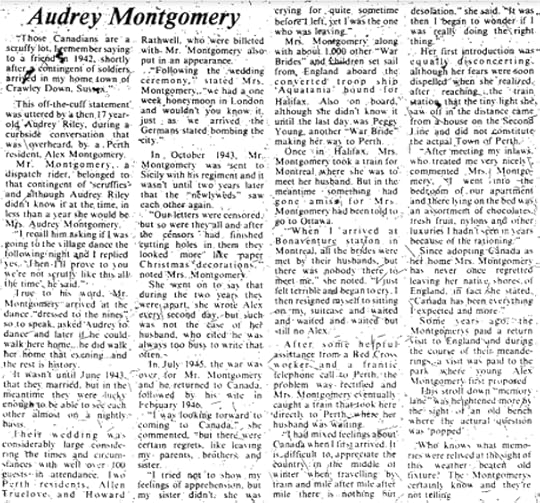
“Alex Montgomery was sent to Sicily in October 1943 with his regiment and it wasn’t until two years later that the newlyweds saw each other again.”
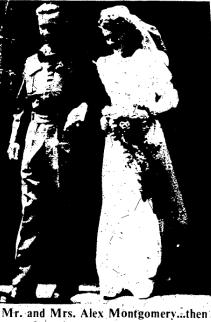
Mr. and Mrs. Alex Montgomery…..(1986)
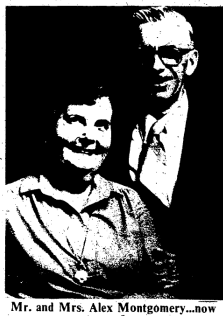
Peggy Young
Peggy (Bartholomew) Young (1924-2012)
Peggy was the daughter of Samuel and Florence Bartholomew of Surrey, England
“It was 1943 at the West Croydon Arena near London, that I first laid eyes on him.”
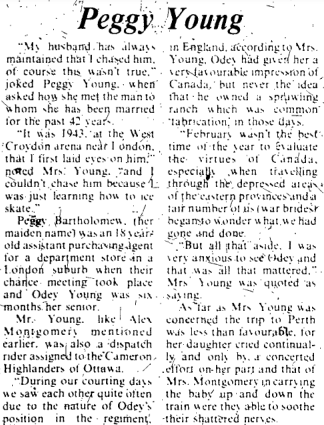
Odey Young (1924-2002) – Odey was the son of Ernest and Gladys Young, and a sibling to Bob, Iris, Lois, Donald, Maynard, George, Jimmie, Gladwyn, and Annie
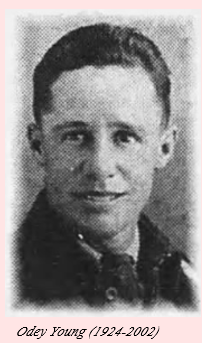

(Peggy Young passed away at age 87. She was predeceased by her husband, Odey Young. She and Odey had three children: Jennifer, Pamela and Deborah)
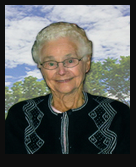
“Since the end of WWII thousands of War Brides left their native homeland and followed their husbands to North America where they eventually assimilated themselves into a new and different way of life.
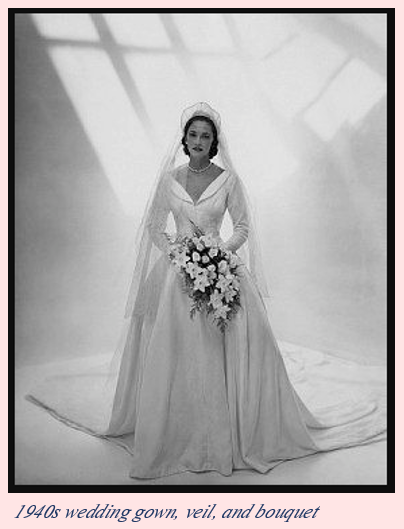
Few, if any, ever regretted leaving behind family and friends and if they did so it was for only a short time because it was natural that they would make new friends and adopt Canada as their homeland.”
I hope you enjoyed this special tribute to some of our forgotten heroines of the war who left their homes and settled in a new land, with their handsome young soldiers – the War Brides of WWII.
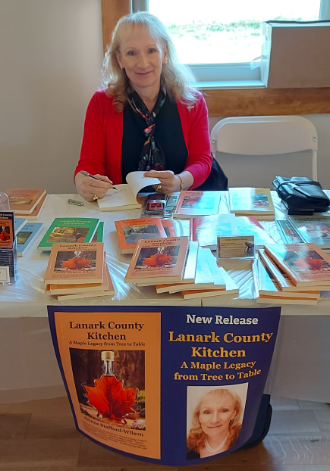
Arlene Stafford-Wilson
Honorary Life Member, Lanark County Genealogical Society
Member, Association of Professional Genealogists
Author of : “Lanark County Kitchen”, “Lanark County Christmas”, “Lanark County Comfort”, “Lanark County Collection”, “Lanark County Calling”, “Lanark County Classics”, “Lanark County Connections”, “Lanark County Calendar”, “Lanark County Chronicle”, “Lanark County Kid”, & “Recipes & Recollections”
November 2, 2023
Finding Our WWI Ancestors
Short days ago we lived,
felt dawn, saw sunset glow,
loved and were loved,
and now we lie in Flanders Fields.” — John McCrae
Over 600,000 men and women enlisted in the Canadian Expeditionary Force (CEF) during the First World War, (1914-1918) as soldiers, nurses and chaplains. The CEF database is an index to those service files, which are held by Library and Archives Canada.
This free online searchable database includes over 600,000 men and women who participated in WWI (1914-1918) including soldiers as well as nurses and clergy:
WWI Canadian Forces Personnel Records
These service files contain the name, address, service number, name of the next of kin, their physical description , skin colour, eye colour and scars or identifiable markings, and the unit number and location where they signed up for service.
On this site you can find links to the soldier’s file, which contain medical and pay records, and encompass a more detailed personal history of the soldier, and includes the specific units where they served, after going overseas. The soldier’s full service records are not available online, however, they may be ordered for a fee from Library and Archives Canada.
Also available are links to the Canadian Virtual War Memorial if the soldier died while in service.
War Diaries – This is a link to the diaries of the unit, not to personal diaries, but of the records of day to day life in a particular unit. This will give you great insight to how your ancestor lived in times of war in their group as they trekked across Europe and participated in various battles – some successful and some not.
Using the resources and links mentioned in this article, I was able to search and locate cousin Harry Stafford’s enlistment papers, his detailed medical files, including x-ray images and comments from attending physicians, his pay statements, physical description, and name and address of his next of kin.
I was also able to find out about the specific battle where he was wounded and subsequent hospitals in Europe where he received treatment. The records also state his date and condition at discharge, and pay records of any amount owing.
Harry’s story begins with the 130th Battalion, Lanark and Renfrew Scottish Regiment which was the ‘130th also known as the ‘overseas’ Battalion, based in Perth, Ontario.
They began recruiting in the fall of 1915, in Lanark and Renfrew Counties.
Harry’s StoryNine-year old Harry stood by the shore, and watched in horror as his eldest brother Wilfred struggled to the surface again and again, until he finally slipped out of sight into the deep blue waters of the Mississippi River near Lanark.
Harry and his brothers often played near the water, although none of them could swim. The four brothers stood on the shore that fateful day in July, and skipped stones on the surface of the water, just as they had so many times before.
Wilfred, two days shy of his thirteenth birthday, was the eldest of the four. He took great pride in showing his younger brothers how to pick the longest flattest stones. He coached them on how to hold the stones on their flat side, and throw them parallel to the water, so they would skip farther along the waves. Dick, at age ten, was beginning to get the hang of it. Harry and his twin brother Frank had turned nine two months before and were doing their best to keep up with the older boys.
Harry, the stronger and more athletic of the twins was trying to help his brother Frank as he struggled with the task. Frank had kyphosis which meant that he had a severe curvature of the spine. People in those days referred to Frank as a ‘hunchback’, but he was still able to do most things; although it might take him a little longer.
One of the boys had thrown his prized pocket-knife into the water by mistake, and Wilfred had gone into the water to retrieve it, slipped on a rock and fell into a deep hole, unable to swim, and drowned. The younger boys had raced back into Lanark to get help, but it was too late. By the time they had met up with the first grown-up it was already after five. Mr. Baker, the local tailor in Lanark hurried back to the spot, and pulled Wilfred’s lifeless body from the river.
Mr. Baker laid the body gently on the shore, and headed back to the Stafford home to deliver the news. Harry’s mother Mary (Murphy) Stafford was pregnant with her next child Carmel at that time, and both she and Harry’s father Peter were overcome with grief.
This would be Harry’s first, though not his last encounter with death at a young age. Two years later in the spring, his mother once again gave birth to twins – this time a boy and a girl – Rose Marie and Martin Wilfred, named for his late brother. The twins were born in the spring, and Harry’s parents were delighted to welcome the new babies into their growing family. Sadly, tragedy struck once again, and Harry’s new little brother Martin Wilfred, the weaker of the two passed away quietly, just seven weeks after his birth.
A few short years after the second tragic event in Harry’s family, war was declared in Europe. Canada was still under British rule at the time and as such would be expected to join in the war efforts overseas.
Within the next couple of years tales of the excitement and adventure on the front lines travelled back to Perth, and acts of heroism and valour were recounted in the local papers. Life on the farm, and the daily chores seemed mundane, compared with the glorified life of a soldier fighting for freedom.
The 130th Battalion, Lanark and Renfrew Scottish Regiment which was the ‘130th “Overseas” Battalion, CEF’ Based in Perth, Ontario, began recruiting in the fall of 1915 in Lanark and Renfrew Counties. When a recruitment officer arrived in the village of Lanark one winter, young Harry, just sixteen at the time lied about his age and signed up on the spot.
The Canadian Expeditionary Forces, as they were known, specifically recruited men between the ages of 18 and 45, so Harry claimed that he was born the same year as his brother Dick and was actually eighteen years old. They took him at his word, and Harry became an enlisted man on January 9th, 1916.
Harry, along with some local lads, was sent for basic training in Valcartier, Quebec and returned home for a brief visit before going overseas.
August 4 1916 – ‘The Perth Courier’“Corporals Ronald Scott, William Strang and Jack Scott (McDonald’s Corners) and Privates Lance Affleck, Ralph Craig, John Kingston, Harry Stafford, Henry Barrie (Watson’s Corners), and Joseph Bennett (Fallbrook) of the 130th Batt., Valcartier, are home on a week’s furlough – their farewell visit before going overseas.” (Harry was 17 by then)
The 130th Battalion left the Halifax harbour and sailed for Britain on 23 September 1916. After two weeks at sea, arriving in Liverpool, England on October 6th, Harry and the other members of the unit were absorbed by the ’12th Reserve Battalion, CEF. Their prime function was to provide reinforcements for the Canadian Corps that were already fighting in the field.
After fighting bravely in both England and France, Harry found himself participating in one of the most significant campaigns in WWI. Known as the Third Battle of Ypres (or Passchendaele) this battle was remembered both for its tremendous loss of life and casualties and because of the horrendous conditions of the battlefield.
The siege of Passchendaele went on for over three months from July through November 1917. More than 4,000 Canadians died and over 12,000 were wounded. The battlefield consisted of flat, swampy lowlands, and when heavy rainfall pounded the fields that autumn, the ground became a sea of mud. The men had to struggle through the thick mud with very little cover, while German soldiers tore them to pieces with their machine guns.
By November the Canadians were finally beginning to win the battle and began to push the Germans back from their stronghold. It was on the 6th day of November 1917 that 18 year old Harry was wounded in the leg by German gunfire at Passchendaele.
Harry was dragged out of the line of fire, received basic care from one of the medics to stop the bleeding and was sent to a hospital in England. He was admitted two days later on November 8th.
Word of Harry’s injuries was sent to his parents, back on the farm, in Lanark:” Mr. and Mrs. Peter Stafford received a telegraph from the Director of Records, Ottawa, on Friday, informing them that their son, Pte. Harry Stafford, 787104, had been wounded by gunshot in thigh and leg on Nov 6th, and admitted to No. 6 Field Ambulance Depot. Harry went overseas with the 130th Batt. in September, 1916, was transferred to another battalion for service in France, and has been through some severe engagements since crossing the channel. His many friends hope that Harry’s wounds are not serious.”
—-21 November, 1917, “The Lanark Era”The medical care during WWI was a very complex set of institutions, which cared for wounded soldiers from the battlefield, as soon after injury as possible. The soldier was evacuated as quickly as possible for treatment, and provided care.
The Field Ambulance was a mobile unit equipped with horse-drawn ambulances. They brought soldiers from the battlefields to an Advanced Dressing Station located at the rear of the siege out of harm’s way.
After Harry was shot, the first day he was sent to the #6 Field Ambulance Nov 6 1917, and after a month’s time was transferred to the Pavilion General Hospital Brighton Nov 23 1917, for three weeks.
Harry’s condition was not improving, and he suffered infection after infection. He was transferred to the Military Convalescent Hospital at Woodcote Park, Epsom, England on Dec 22, 1917 and he remained there receiving treatment for four and a half months.
In March 1918 he was transferred to Bramshott Military Hospital, where he was treated for one month, with still no sign of improvement.
It was during this time that Harry received word from his parents at home that his brother Carl had enlisted in a month earlier, and like Harry had lied about his age in order to join the service.
On July 8th, 1918 Harry was admitted to the Granville Canadian Special Hospital in Buxton, Derbyshire, England.
In November of 1918 WW1 finally ended. Losses of human life by Canadians and the allies were in the thousands.
After six months of unsuccessful treatment at the Granville Hospital in England Harry was finally discharged on December 3rd, 1918.
His condition continued to deteriorate, and on December 23 1918 Harry embarked for Canada sailing on the S.S. Tunisian.
Due to his medical condition, Harry was discharged from the military at Ottawa, on February 5, 1919.
Jan 10 1919 Perth Courier:“Pte. Harry Stafford, son of Mr. and Mrs. Peter Stafford, Lanark, returned home Monday from overseas. He went overseas with the 130th Batt. In November 1917 he was wounded in the leg and latterly has been receiving hospital treatment in England.”
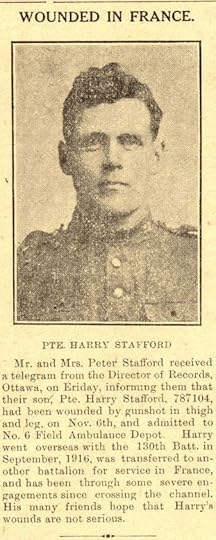
Harry’s condition never improved, and once again he was admitted to St. Luke’s Hospital in Ottawa on February 4th, 1920. He developed a cold two days after being admitted, and his operation was postponed until Feb 9th. Pneumonia developed 12 hours following operation, and Harry died two days later. There was speculation at the time that he may have contracted the flu while in the hospital, and that it turned to pneumonia in his already weakened state.
The influenza pandemic of 1917-1920 was a global disaster, and was actually responsible for killing more people than WWI. It has been said that it was the most devastating flu epidemic in recorded world history.
Because of the close quarters and huge troop movements during the war it is possible that these two factors hastened the pandemic and likely increased transmission of the virus. Many soldiers’ immune systems were weakened by lack of proper nutrition, the stresses of combat and chemical warfare, increasing their susceptibility to any illness.
Feb 20 1920 –“Died: In St. Luke’s Hospital, Ottawa on Thursday February 12th, Harry Alphonsus Stafford, son of Mr. and Mrs. Peter Stafford of Lanark, aged 20 years and 9 months.”Because he died at St. Luke’s Hospital in Ottawa, Harry’s death was registered in the County of Carleton, Division of Ottawa. His official cause of death was listed as pneumonia.
After a quick search on Ancestry.com, I found Harry’s death certificate:
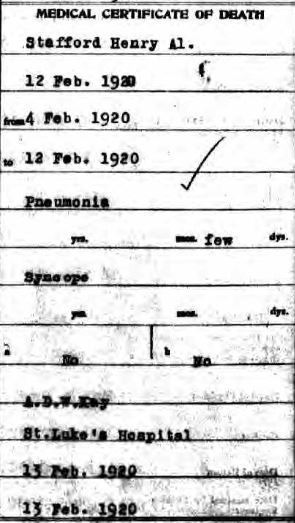
Harry is buried at the Sacred Heart Cemetery, Lanark, Ontario
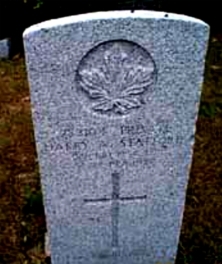
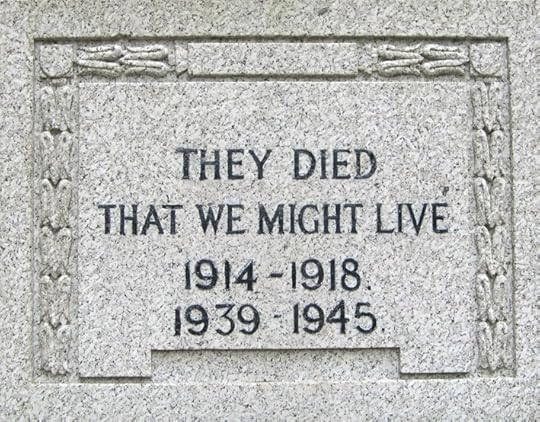
……………………
War Memorial, Ottawa, Canada

There are several resources listed below to help with your search.
……………………………………….
(the above is an excerpt from a book on the life and military service of Pte. Harry Stafford. The hard-cover book is available for research purposes at the Lanark Museum, 80 George Street, Lanark Ontario lanarkanddistrictmuseum@gmail.com, and at Archives Lanark, 1920 Concession 7 Road, Drummond Centre, Perth, Ontario adm.archiveslanark@bell.net)

 Lest We Forget
Lest We Forget………………………..
Link to: Canadian Soldiers of WWI
Link to Commonwealth War Graves
Link to Names in Book of Remembrance
…………………………
Arlene Stafford-Wilson
Member, Association of Professional GenealogistsHonorary Life Member, Lanark County Genealogical SocietyAuthor of : “Lanark County Christmas”, “Lanark County Comfort”, “Lanark County Collection”, “Lanark County Calling”, “Lanark County Classics”, “Lanark County Connections”, “Lanark County Calendar”, “Lanark County Chronicle”, “Lanark County Kid”, & “Recipes & Recollections” and new for 2023 – “Lanark County Kitchen: A Maple Legacy from Tree to Table”available at local stores or email: lanarkcountybooks@gmail.comOctober 30, 2023
Mystery of St. James Church, Hood’s

St. James United Church & Cemetery – Lot 16, Con. 2, Dalhousie Twp., at Hood, Lanark County, Ontario

“Who owns the property now?”

Oct. 28, 1971
“Early this year, after much consideration and discussion among the parishioners, the church was tendered for sale. The response passed all expectations, and, on September 10, 1971, the old pioneer church was sold to Mr. and Mrs. Eric Davis of Seattle, Washington, who plan to remodel it into a permanent home.”
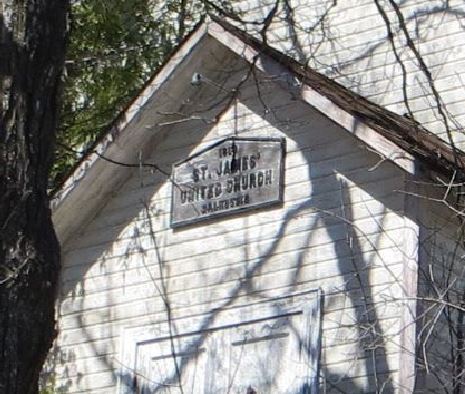
Sign on St. James’ United Church
An article about St. James Church was dated October 28, 1971, written over 50 years ago, by an anonymous author, and published in “The Perth Courier”. According to the author, the church had just been sold, with the promise that it would be remodeled and loved once again, by its new owners. For reasons unknown, the building was never touched, and it stands today, abandoned, with the original ‘St James’ sign attached, looking a little worse for the wear, the fact that it’s still upright, a tribute to the pioneer builders who constructed this church in 1860.
Area known as Hood, or Hood’s Corners
Hood, named for the Hood family who settled there, and most likely for William Hood, educated in the University of Glasgow, the teacher at Hood’s Corners School. William was the son of James Hood, who came from Scotland along with others, on the ship, “Prompt”.
The very earliest settlers to the area came in the fall of 1820, Scotsmen from Glasgow and Paisley. James Blair, John McLellan, John McNangle, Neil Campbell, Donald McPhee, James Martin, William Barrett, Charles Bailie, James Watson, George Brown, Thomas Easton, George Easton, Edward Conroy, Peter Shields, John Donald, John Duncan, Andrew Park, James Park, John Todd, William Jack, James Hood, Alex Watt, Robert Forest, George Richmond, and John Duncan were among the first to arrive.
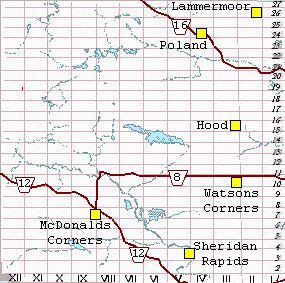
St. James Church
The article from “The Perth Courier” (author unknown) Oct. 28, 1971
“The little white church on the top of the hill at Hoods, two miles north of Watson’s Corners, is now awaiting a new tenant.
The St. James’ United Church, which was built in 1859, holds many memories for the older inhabitants of the area. In the early days, people walked from Elphin, McDonald’s Corners and other communities to worship. Also, stables were provided for the convenience of those who came by horse and buggy.
The church, guarded by three large maple trees, is enclosed by wire strand fencing. An unusual aspect of this is that the cedar posts are ornamented, and the wire is threaded through the posts horizontally. On the top of each vertical wire is a small metal maple leaf. Early this year, after much consideration and discussion among the parishioners, the church was tendered for sale. The response passed all expectations, and, on September 10, 1971, the old pioneer church was sold to Mr. and Mrs. Eric Davis of Seattle, Washington, who plan to remodel it into a permanent home.
On Thanksgiving Day, October 11, an auction sale was held of the church furnishings which drew a large crowd of people. Some were bargain hunters while others came to buy a memento of their former place of worship.
Steeped in history, the church had many ministers, the first being the Rev. John Robb, who came from the Dutch Reformed Church in the United States. He was inducted on May 29, 1846, and services were first held in the old St. Andrew’s Hall. The Rev. Robb died on May 27, 1851, and was buried on the Hall property, but it was not until 1930 that the grave was marked with a headstone. The Rev. Robb donated a silver communion urn and goblets inscribed, “Scotch Church, Dalhousie, Canada West, Rev. J. Robb.” These were in use at St. James’ Church for many years and now will be placed in the museum.
Following the death of Rev. Robb, Dalhousie came under the supervision of the Lanark ministers. Early in 1859, Middleville and Dalhousie became one field, under the direct ministry of Rev. William Clarke. It was during his ministry that St. James’ Church was built. He inspired the congregation to have a place of worship entirely dedicated for this purpose. The walls were raised in the Fall of 1859, but it was not used for worship until 1860.
The building was erected without financial assistance from outside sources. The work was done as money became available from the congregation and the church was used before the interior was completed.
The first seats were hand-made, being square-backed and not made for comfort. They were placed down each side of the church, making one center aisle. Because of the long length o the seats, the offering was collected by means of a velvet pouch fastened to the end of a long rod.
It seems as if the year 1894 was a prosperous one as several projects were accomplished. The walls were plastered and painted a pale green, new pews were installed, and a new pulpit added, along with chairs and a carpet. The Session House was built in 1862 and a woodshed in 1895. The pine log walls of the church were clapboarded in 1896 and the windows were frosted in 1897.
From 1860 until the first organ was installed in 1895 there was a special box-like pew before the pulpit. Here sat the Precentor, who pitched the key for singing, using a tuning fork. Mr. David Easton performed this duty for many years.
Since the land for the church site was donated by James Reid, it was his wish that the church be named, “St. James”. Mr. Reid kept a diary in which many of the facts of the pioneer history of the community were recorded.
During the early years, the Bible Society made annual visits to St. James’ Church and the representative would stay overnight with Mr. Reid. It was also recorded that the trees in front of the church were planted by William Penman and David Forbes.
The Synod Minutes of 1860 reveal that the Rev. William Clarke was paid $94. semi-annually. This money came from Middleville, Dalhousie and Lanark. His last service was held on February 26th, 1865. He was known as a very capable speaker and made a great contribution to this area.
During Rev. McConnells’ ministry, the first manse at Watson’s Corners was built in 1893, and the next year the Zion Church was built at Watson’s Corners.
During Rev. McLean’s ministry in 1908, the Manse was burned to the ground on August 20, but was rebuilt immediately after the fire.
It was during Mr. Clark’s ministry in January 1965 that St. James’ Church amalgamated with Zion Church at Watson’s Corners, when services were held at each church on alternate Sundays.
In June 1965, St. James’ Church was closed, along with several other churches in the district. Since then, the people of St. James’ congregation have been known as St. Andrew’s of Central Lanark Charge, and they attend church at Watson’s Corners.
During the past six years, only two worship services have been held in the pioneer church. One was on August 13, 1967, when the Machan reunion held a special centennial service with the Rev. L. M. Somerville, of the Machan clan, as speaker. The last service was held on September 26, 1971, to honour the forefathers of the congregation with the Rev. E.C. Brown, Minister of St. Andrew’s officiating. He gave an inspiring message that was appropriate for the historical occasion. During the service, the choir sang the anthem “The Beautiful Garden of Prayer”, while Mr. Harry Stead gave a sole, “Others”
In the past 105 years, St. James’ Church was used as a sanctuary. Hundreds of worshipers from miles around received spiritual blessings and encouragement to carry on their daily tasks. Many people will treasure in their hearts the many happy memories of hours spent in fellowship and spiritual help received at St. James’ Church.”
The ministers of St. James’ Church:
1860-1864 Rev. William Clarke
1865-1871 Rev. Donald J. McLean
1872-1879 Rev. Wm. Cochrane
1881-1893 Rev. Joseph Andrews
1893-1895 Rev. James McConnells
1896-1903 Rev. James Leitch
1903-1909 Rev. J.R. Miller
1906-1909 Rev. J.A. McLean
1910-1916 Rev William Ferguson
1916-1920 Rev. J.R. Wilson
1920-1928 Rev. J.T. Caswell
1928-1931 Rev. Henry Scott (for a few months in 1931 Rev. J.H. McLaren)
1931-1937 Rev. L.N. Beckstead
1937-1939 Rev. Harry Peters
1939-1942 Rev. R.A. Cameron
1942-1943 Mr. H.C. Mercer
1943-1956 Rev. D.J. Campbell
1956-1962 Rev. Fred Wakeling
1962-1965 Mr. L.V. Clark
Property Sales History: (West half of Lot 16, Concession 2, Dalhousie Township, Lanark County)
June 27, 1844 – the Crown transfers 100 acres to the Canada Company
Feb. 6, 1857 – James Reid purchases 100 acres, rear (or west half) for 75 pounds
Mar. 24, 1859 – James Reid sells (donates) to the Presbyterian Church Trustees 22,500 square feet for the sum of $2.00
Dec. 2, 1971 – Lorne Pretty and Keith McNicol (Chairman and Secretary of the Trustees of St. Andrew’s Congregation of Central Lanark Renfrew Presbytery, of the United Church of Canada) – sell the church property 150 ft. by 150 ft. (22,500 square feet)
to Eric Davis and Chloe Davis, for the sum of $2,950.
(this was the last listed transaction in the historical records)
Source: the historical records of the Ontario Land Registry, (Lanark County LRO 27), Dalhousie Township, Concessions 1-3, p.130
Abandoned at Hood’s
No one seems to know what happened to the owners of the property, or why the old church wasn’t remodeled into a family home, as was the original intention, discussed with the parishioners of St. James, over 50 years ago.
The Davis family was from Seattle, Washington. Were they vacationing in the area when they decided to purchase the church? Did they ever return to Hood’s?
Whatever the reason this historic pioneer church was never remodeled by the owners remains a 50-year-old mystery.
Sadly, this abandoned house of worship with its traditional-style interior are examples of early architecture by the Scottish pioneers. Part of a proud community, this building witnessed many baptisms, marriages, and funerals of the community’s early Scottish settlers, a refuge and sanctuary for the new emigrants, as they forged their way in the new land.
Perhaps we’ll never know the real reasons that St. James Church was abandoned by its owners.
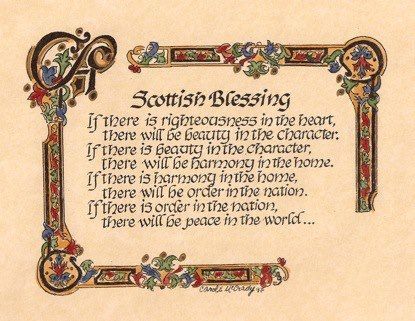
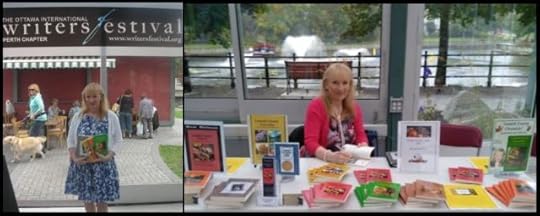
Arlene Stafford-Wilson
Honorary Life Member, Lanark County Genealogical Society
Member, Association of Professional Genealogists
Author of: “Lanark County Christmas”, “Lanark County Comfort”, “Lanark County Collection”, “Lanark County Calling”, “Lanark County Classics”, “Lanark County Connections”, “Lanark County Calendar”, “Lanark County Chronicle”, “Lanark County Kid”, & “Recipes & Recollections”
new for 2023: “Lanark County Kitchen: A Maple Legacy from Tree to Table”
Ferguson’s Falls – Celebrating Archives Lanark
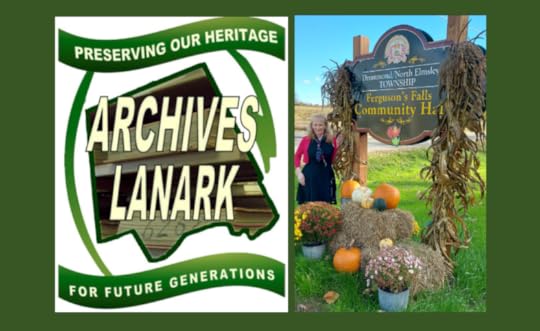
It’s hard to believe that it’s been over 20 years since Archives Lanark was established – a place to store Lanark County’s precious original land records, wills, family histories, historic photos, and more. The shiny new community hall in Ferguson’s Falls was the perfect spot for the celebration. It was an afternoon of music, creative historical displays, guest speakers, local authors, and many lively discussions for all those interested in local history.
For me, it was a return to the ‘home soil’, the community where it all began for our Stafford ancestors when they arrived in 1816 from southern Ireland. These were the same roads where our father brought us on those Sunday drives, always with a stop at Lloyd and Evelyn Dickenson’s store for an ice cream, and a visit to St. Patrick’s cemetery, the final resting place for all those who came before us.
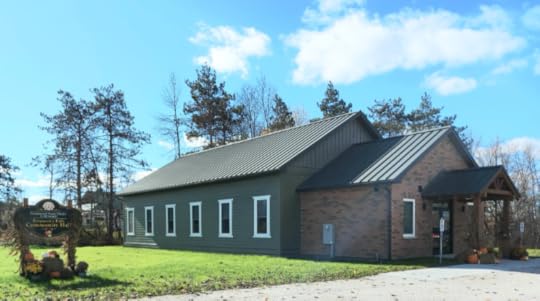
The impressive new Ferguson’s Falls Community Hall is a lovely addition to the gently rolling landscapes along the Mississippi River.

The clear blue river flows peacefully behind the new hall, serving as a reminder of those who established this historic community along these peaceful waters, over 200 years ago.
For anyone not familiar with the history of the area, the hall features an outdoor storyboard telling the tale of Ferguson’s Falls and the community’s fascinating history in Drummond Township/North Elmsley.
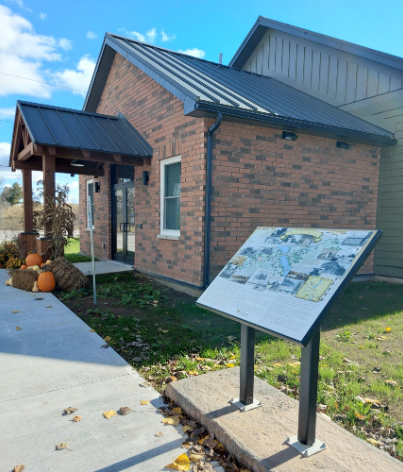
An enlargement below shows some of the detail on the storyboard outside of the hall:

Visitors to the hall were warmly welcomed, and many signed the guest book at the door. A local band, “Memory Lane”, played throughout the afternoon, providing some toe-tapping, hand-clapping, country favourites.
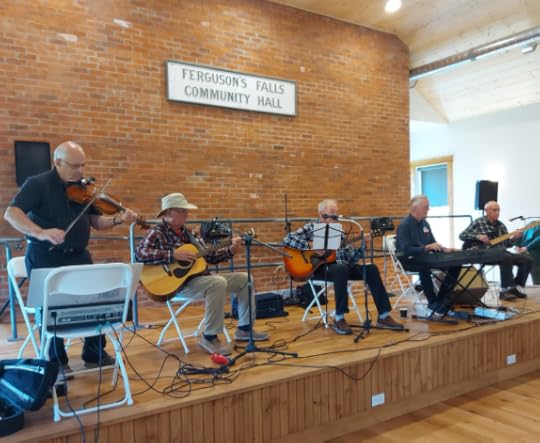
Band Members: John Miller playing fiddle, Mark Labelle, Leo Scissons, Grant McFarlane and Tom Gardiner
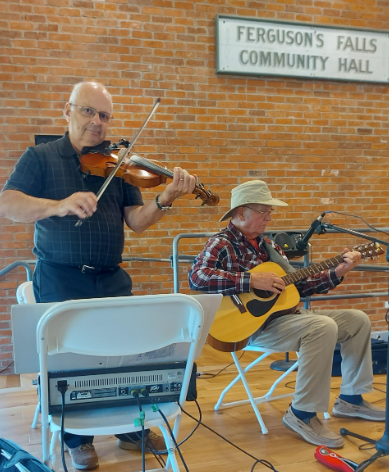
John Miller and Mark Labelle
One of the highlights was a delightful rendition of an old favourite, “Maple Sugar”, the perfect song for any celebration set in Lanark County, the maple syrup capital of Ontario. John Miller had the crowds smiling with his expert fiddle playing, and the band’s sound was tight and skilled, with every note played to precision, a reflection of the many years the band has performed together.

Leo Scissons, Grant McFarlane and Tom Gardiner
There was not a sign of any sheet music or written notes on this stage, as these talented musicians entertained the crowds all afternoon.

John Miller playing fiddle, Mark Labelle, Leo Scissons, Grant McFarlane and Tom Gardiner
All were invited to enjoy some delicious refreshments as they listened to the music and strolled around taking in the displays. One of the highlights was a beautifully decorated 21st Anniversary cake featuring both chocolate and vanilla – perfect with a steaming hot cup of tea or coffee from the brand new kitchen in the hall.
Members of the Lanark County Genealogical Society were on hand, with an extensive display of their books on local history. Long-time member, Marilyn Snedden, set up and maintained the display throughout the day, answering questions and selling the society’s many historical publications.
There were some amazing displays highlighting our local history, and just a small sampling of what can be found at the Archives Lanark.
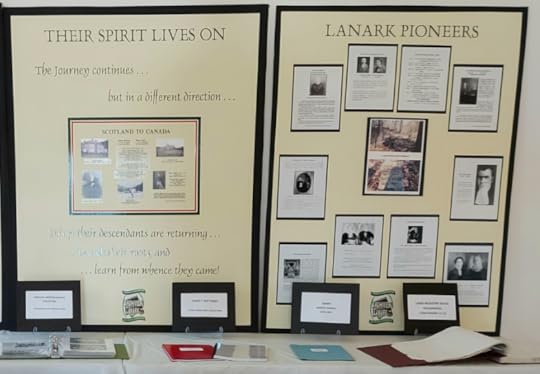
One of the many story-boards featured at the celebration.
The local history buffs were in seventh-heaven, taking in all the colourful displays, and discovering some of the research materials available at Archives Lanark.
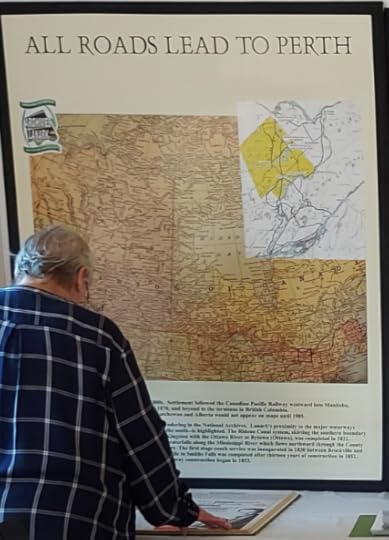
One of the exhibits featured a fascinating slideshow, highlighting some of the events attended by members of the Archives Lanark team.

(one of the many displays at the Archives Lanark 21st anniversary celebration)
Local historian and author, Ron Shaw, gave a delightful talk, highlighting some of the fascinating history of the Archives Lanark.
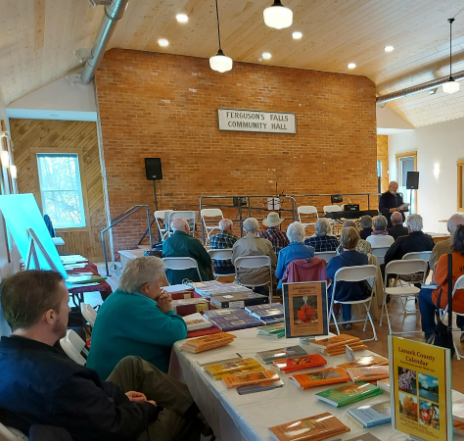
Ron is no stranger to local history and kindly shared his knowledge with the crowds
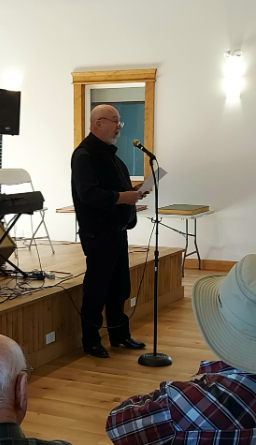
Ron Shaw, Member, Perth Historical Society
Frances Rathwell, Chairperson for Archives Lanark shared some impressive facts about the organization and its value to the community. At one point all of the seats were filled and some were standing at the back of the hall.

Frances Rathwell, Chair, Archives Lanark
They say, “it takes a village”, and Archives Lanark took the opportunity to honour one of their long-time volunteers, Ruth Bowes, at the celebration.
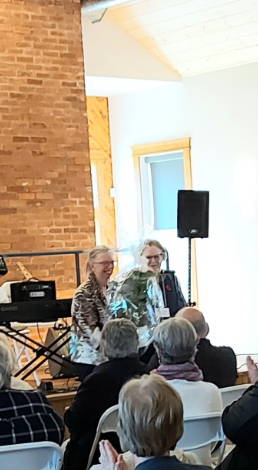
Volunteer Award -presented to Ruth Bowes by Frances Rathwell
Ruth Bowes has worked for many years at Archives Lanark. She has been a part of the Rural School Book Series, and has indexed many scrapbooks, enabling researchers to find information quickly and efficiently.
Wendy Roberts, also spoke to the many history-buffs gathered in the hall. Wendy is CAO, a member of the Board of Directors for Archives Lanark.

Wendy Roberts, CAO, Archives Lanark
Along with the music, the refreshments, the speakers, the storyboards, and slideshows, the anniversary celebrations featured an Author’s Table, with myself, Ron Shaw, and Rosetta McInnes.

There was a steady stream of visitors with many lively discussions on local history, genealogy, some familiar faces, and some new faces as well.
I brought some copies of my new book, “Lanark County Kitchen: A Maple Legacy from Tree to Table”, and also some copies of my other books.
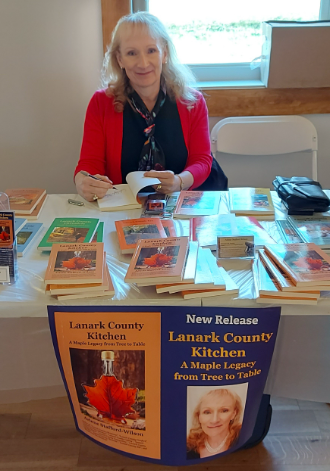
Arlene Stafford-Wilson
Ron brought a number of his books, a few of them seen below:

There were lots of great opportunities to chat during the event, and my husband, Kevin Wilson and Ron Shaw, shared a conversation at the Author’s Table.
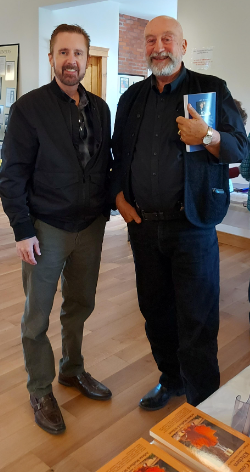
Kevin Wilson and Ron Shaw
It was great fun having Ron on one side of me at the Author’s Table, and the talented Rosetta McInnes on the other. Rosetta recently published a history of the Perth Police and was busy signing copies of her latest book. She also brought copies of her book, “Just Over There”, which documents the history of South Sherbrooke’s sugar camps.
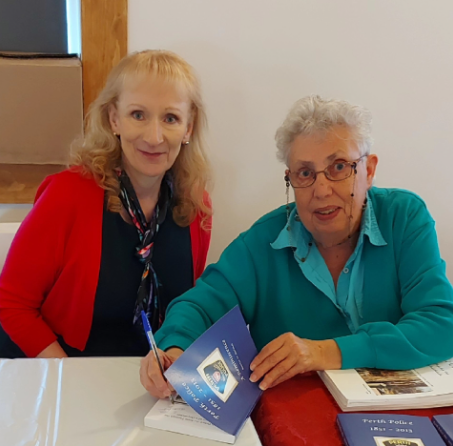
Arlene Stafford-Wilson and Rosetta McInnes at the Author’s Table
What a busy day at the Author’s Table!
Well, as they say, all good things must come to an end, and as the late October sun sank low in the sky, it was time to say good-bye and leave the Ferguson’s Falls Community Hall.

Thanks to Wendy Roberts and Archives Lanark for inviting us to this special event marking their 21st Anniversary in the community. It was great re-connecting with some old friends, and making some new friends as well. Thanks to Memory Lane for the wonderful music, and to all who stopped by the Author’s Table. It was a busy day! Happy and full of delicious cake and hot tea, we walked back to the car and headed down the same roads that our ancestors traveled, past St. Patrick’s Church and cemetery, across the clear blue Mississippi, feeling thankful to Archives Lanark for all their efforts in preserving our local history.
Special thanks to:
Archives Lanark Board of Directors: Frances Rathwell, Chair; Marilyn Snedden Vice-Chair; Wendy Roberts CAO; Karen Prytula, Secretary; Grant McFarlane, Treasurer; Rose Mary Sarsfield, Director; Barbra Apro, Director; Klaas Van Der Meer, Director; George Stewart, Director; John Matheson, Director.
For more information about their collection:
Archives Lanark
1920 Drummond Concession 7
Perth, Ontario
K7H 0K6
Email them at: info@archiveslanark.ca
or visit their website:
https://archiveslanark.ca/index.php
(thanks also to Kevin for capturing all of the special moments with his skillful photography throughout the event)

Arlene Stafford-Wilson
Honorary Life Member, Lanark County Genealogical Society
Member, Association of Professional Genealogists
Author of : “Lanark County Kitchen”, “Lanark County Christmas”, “Lanark County Comfort”, “Lanark County Collection”, “Lanark County Calling”, “Lanark County Classics”, “Lanark County Connections”, “Lanark County Calendar”, “Lanark County Chronicle”, “Lanark County Kid”, & “Recipes & Recollections”
October 26, 2023
Perth’s Haunted Hospital

It wasn’t until I worked at the Perth hospital kitchen in the 1970s, that I began hearing stories about the ghosts that haunted their halls at night.
Although I was born in the Great War Memorial Hospital, and years later would attend high school just a block away, no one had ever mentioned the legends surrounding the original owners of the building, or how that family had been cursed.
Curious to find out more, I began to ask around town. Being a small town where everyone knew someone, who knew something; it didn’t take long before I spoke with someone, who knew someone else, who’d seen something unusual at the old hospital. I began to write down some of the stories about the building on Drummond Street that I thought, had always been a hospital. I discovered that it hadn’t started out as a hospital at all.
The story begins with a Judge John Malloch, a prominent citizen of the early days in Perth, who decided in 1858 to build an opulent stone house on Drummond Street. His home had all of the bells and whistles. There were 17 rooms, along with two large halls that were each ten feet wide. There was a solid walnut staircase, a large library, and a fine polished marble mantelpiece. In those days, it was considered by many, to be one of the finest homes in all of Eastern Ontario. The Judge named the home Victoria Hall, for the reigning Queen at that time.
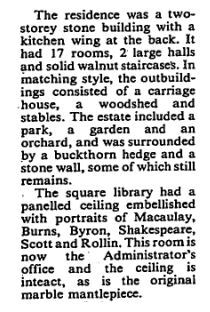
Judge Malloch had ordered many luxurious materials and finishes for his home, some from a distance, and he often became impatient because his building supplies didn’t arrive on time. One of his suppliers had promised delivery on a certain date and the materials did not arrive when needed. This caused a critical delay in construction. Workers were not able to proceed, and the setback cost the Judge a great deal of money. When the material finally arrived, the Judge was so annoyed that he refused to pay.
The supplier became extremely agitated, because even though he admitted that he was very late, he stressed to the Judge that he had delivered the supplies as agreed, so he felt that he should be paid. The supplier argued at length with the Judge, but Malloch stood firm and refused to pay. In the heat of the argument the supplier cursed the Judge. He went on to say that the Judge’s entire family would be cursed for as long as they lived in that house.
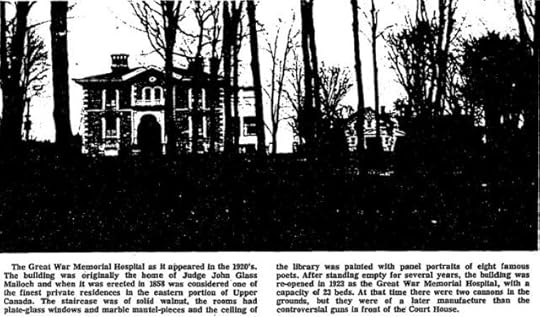
Years later, some would say that it was the curse, and some said that it was merely coincidence, that caused the Malloch family members to suffer ill health. Some even succumbed to death prematurely. The old Judge watched as they passed one by one, and he was left all alone in the large stately house.
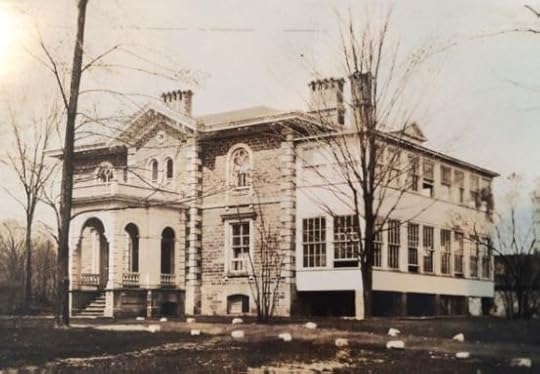
Fifteen years after the house was built, the old Judge died, and the once elegant Victoria Hall was left vacant.
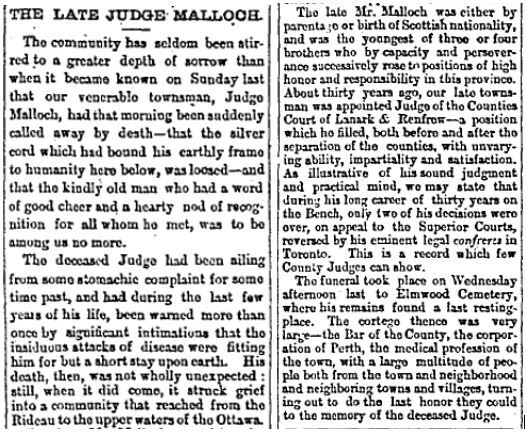
The only time the house was occupied was when distant family members would open the home for the summer season, stay briefly, then leave the house empty and dark for the remainder of the year.
It was during this time, when the house was left vacant, that locals passing by at night often noticed figures walking the halls or staring out the windows. Victoria Hall became known as the Haunted House of Perth.
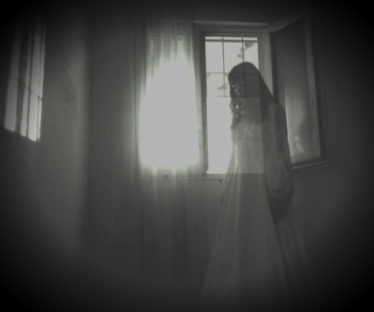
Some said they saw what looked like a thin, sickly. old woman, standing at the window, staring down at Drummond Street below. Others claimed that they saw the ghost of the old white-haired judge, walking up and down the long halls, as if he was searching for something or someone.
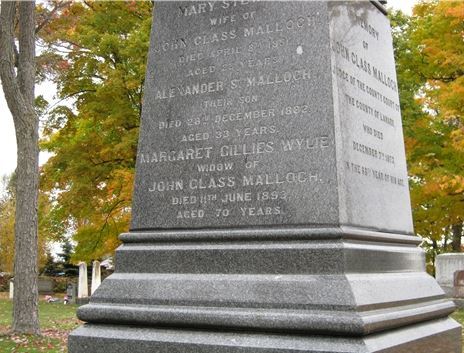
The Perth hospital, in the former Victoria Hall, opened in 1923. On Armistice Day in 1924 the town of Perth dedicated the hospital as a tribute to the men and women who served in World War I, and proclaimed that it would be known as the Great War Memorial Hospital.

By the time I was hired to work part-time in the hospital kitchen in 1976, there had been many additions, although by that time, the number of beds had been reduced. The provincial Ministry of Health imposed bed closures in the obstetrics ward in 1973 and local mothers had to travel to Smiths Falls to have their babies.
I recall that this was a heated issue at the time, and three years later, when I worked in the kitchen, it was still a topic of great discussion. The other topic, which I overheard many times discussed by the staff, were the ghosts that walked the halls at night.
Being a fairly level-headed person, I was inclined to take the ghost stories with a grain of salt, and went about my usual tasks. I’d been hired part-time to work in the evenings, to deliver trays of food to the patients, after school, and on weekend mornings, to help out with the breakfast preparations.
I recall the first day of work, when I went inside the hospital, and asked one of the staff in the lobby if they could tell me how to get to the kitchen. I got directions, and headed down the elevator to the lower level. When I arrived one of the other part time girls, Darlene Dowdall, took me on a tour of the kitchen, and introduced me to the staff. Dorothy Erwin was the kitchen supervisor. She said she’d be happy to answer any questions, and welcomed me to the kitchen. A few years later, Dorothy’s daughter Ruth, married my brother Roger, but that’s another story.
Next, Darlene brought me over to meet the cook. His name was Wayne Clapp, and he had a quick smile, and was joking around with Leonard ‘Lenny’ Parsons, the dishwasher. Wayne was preparing a beef stew, and he showed me the walk-in refrigerators. I couldn’t believe the size of those things. They were huge.
The next person I met in the kitchen was the baker, and her name was Gladys Thomas. She had a warm personality and very kind eyes. The day I met her she was busy making some vanilla pudding. She had a double-decker bake-oven, mounted on the wall behind her, and an enormous mixer for puddings and cakes.
Leonard Parsons, who I’d met earlier, came breezing by and asked if I’d like to start work by helping him wash some of the pots and pans. Darlene said she’d catch up with me later, and I followed Leonard into the dish-washing room.
Mike, the evening dishwasher, poked his head in the door and with a nervous look on his face, told Leonard that ‘Miss Bosch’ was coming. Leonard explained that Miss Gabriela Bosch was the head of the kitchen, the ‘big’ boss, and she would often drop by for a surprise inspection to make sure that everything was done just so.
He had barely finished his sentence when a very tall, dark-haired lady, wearing a white lab coat, poked her head into the doorway, said hello, and asked how everything was going. She was taller than average, and seemed very serious, and I wondered if that’s why the two men had seemed so nervous.
One of the other part time girls Heather Bell, came in and asked me if I could help her fill up the pop machine in the cafeteria. I recognized Heather from school. There were two Heather Bells, one with dark hair, but this was the blonde one, and she went by Heather ‘N.’ Bell so people would know which was which. Heather had a quick sense of humour, and she was a lot of fun to work with that evening. We joked around as we carted in the cases of pop and slotted them into the machine.
I spotted Bill Farrell coming into the cafeteria from the kitchen and he was holding a mop and pushing a bucket on wheels. He was tall and lanky and had a big smile for everyone. I recognized him from Perth High School, and he came over and introduced himself. He and Heather began joking around about some of the good time they’d had with the kitchen gang since they’d started working there and I knew for sure that there would be some fun times ahead.
Another girl from school Joy Hurren, worked behind the counter in the cafeteria, and she asked me if I’d like to help her fill some dishes with pudding. We spent about an hour doing that, and when we finished, we began to shut everything down for the night.
As we turned off the lights in the cafeteria, I heard an odd sound like someone moaning coming from inside the kitchen, but when I pushed the door open there was no one there. Joy just shook her head and seemed to think nothing of it; so, neither did I.
On my second night I worked with Joy’s younger sister Jennifer Hurren. She and I had been assigned the job of delivering supper to all of the patients. There were huge metal racks on wheels called carriers and every six inches or so there was a slot that held a tray of food.
The trays were already set with the evening meals. The dinner plates each had a metal cover to keep the food hot, and some of the trays had pots of tea or glasses of tomato juice or apple juice. Ethel Scott was working that evening putting the meals together. I recognized her because I went to school with her daughters, Judy, Thelma, and Patsy. Ethel was checking to make sure that the meals on the trays matched what the patient had checked off on their order slip.
Once we’d loaded the trays on the carrier, Jennifer and I rode up in the elevator, and stopped on the first floor. The big metal carrier was on wheels, so we pushed it along the hallway and stopped by each room. We made sure to check the slip of paper and match the name with the nameplate on the bed and then we set the tray down. Some of the patients were sleeping, but most were awake and happy to see us, and we chatted for a couple of minutes and then went onto the next room. There was one lady at the end of the hall who didn’t get a tray that night. Her room number wasn’t on the list. I thought to myself that she must have already eaten her supper earlier in the evening.
As the months passed by, I realized that the staff members in the hospital kitchen were a great bunch to work with. There were many jokes shared and stories told while we worked, and every so often someone would mention the ghosts that had been seen in the halls over the years. Well, I’d been up and down those halls many, many, months, and the only folks that I’d seen other than the nurses, were from the Hospital Auxiliary.
The ladies of the Hospital Auxiliary were a dedicated group and sometimes we’d see them in the halls. They’d be upstairs on the floors late at night delivering evening snacks to the patients. They called it the ‘Tea and Toast Brigade’ and brought around hot buttered toast with jam or jelly, and tea or juice to the patients, to provide a little late-night nourishment. Along with offering some cheer and a snack these ladies raised a tremendous amount of money for the hospital. They ran a little gift shop on site, and were also in charge of the Candy Stripers – young girls who volunteered to help out with small jobs around the hospital.
I saw quite a few of the ladies from the Hospital Auxiliary like Miss N. Burke, Mrs. Vi Wilson, Mrs. L. Crothers, Mrs. B Watson, Mrs. K. Frizell, Mrs. S. Folkard, Mrs. E. Rilley, Primrose Paruboczy, Harriet Halliday, and Mary McDougall. They were tireless workers, and it was very clear that they really cared about the patients and the hospital.
I also saw many of the local doctors while delivering the trays of food each evening. Many of them looked exhausted as they made their rounds, but they were always friendly and had a few kind words for us as we wheeled our food carrier down the halls. I remember Dr. Holmes and Dr. David Craig tending to their patients; and also Dr. J.A. Kidd, Dr. R. McLean and Dr. Tweedie.
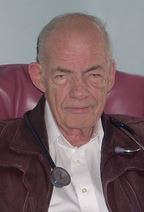
We walked those halls on each floor of the hospital two or three nights each week, wheeling our meal carrier up and down, unloading the trays, chatting with the patients and the hard-working nurses. We dropped the trays off, came back later, picked up the empty trays, and brought them down to the kitchen.
I worked evenings in the hospital kitchen for almost two years. I heard many accounts during my time of staff members seeing apparitions. I thought that they must be imagining things, because I’d walked those halls at night countless times, I never encountered any ghosts at the GWM Hospital.
After graduating from PDCI, I worked two more months at the hospital kitchen, then headed off to college. I treasured the friendships formed there, and the building itself was impressive; particularly the original section of Victoria Hall, which at that time was used for administration. Being a keen student of history, it was interesting to learn about the early days, and also the many expansions and transitions that had taken place over the years.
On my last shift, there was a little gathering in the kitchen, and everyone wished me good luck in college. We loaded the trays in the carrier one last time, and headed into the elevator, and up to the second floor to deliver the evening meals. As we made our way to the end of the floor and emptied the carrier, a nurse walked by, and I stopped her, and asked a question that had been on my mind since I started working there.
“Sorry to bother you, but I’ve always wondered why the lady in the last room on the right never eats her supper at the same time as the other patients?”
The nurse gave me a puzzled look and said, “That’s just a utility room. We use it for storage. There hasn’t been a patient in there for years.”
I felt the blood drain from my face and a shiver ran down my spine, as I looked at her in disbelief, and then looked back down the hall toward the room. Was it possible that I had imagined the pale, slender lady with the snow-white hair, in the faded blue robe? Maybe she was from one of the other rooms …but why did she stand in front of the room at the end of the hall each evening?
The girl I was working with said, “Come on! We’ve got two more floors of meals to deliver tonight.”
The nurse had already started walking back to her station, and my co-worker was pulling the carrier down the hall toward the elevator. I finished my shift that evening, and hung up my smock in the change room for the last time.
I left out the side door that last night as usual, and headed up the curved pathway. Once I reached the sidewalk on Drummond Street, I looked back at the building where I’d worked the past two years. Suddenly it looked different, almost eerie, and I recalled what the nurse had said that night.
Who was that small, frail lady with the snow-white hair that I’d seen so many times? She never ate supper with the others. We never brought her a dinner tray. Was it my imagination? Was it just a coincidence?
Or, perhaps, this really was the ‘Haunted House of Perth’.
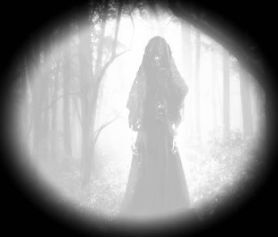
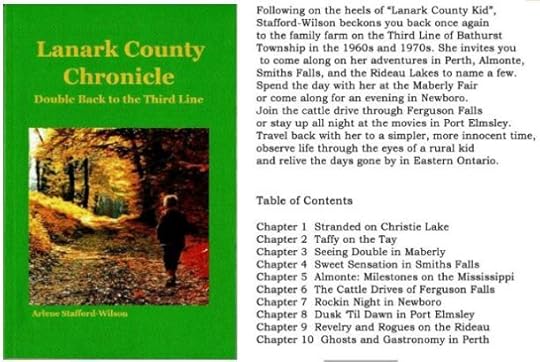

Arlene Stafford-Wilson
Honorary Life Member, Lanark County Genealogical Society
Member, Association of Professional Genealogists
Author of : “Lanark County Kitchen”, “Lanark County Christmas”, “Lanark County Comfort”, “Lanark County Collection”, “Lanark County Calling”, “Lanark County Classics”, “Lanark County Connections”, “Lanark County Calendar”, “Lanark County Chronicle”, “Lanark County Kid”, & “Recipes & Recollections
http://www.staffordwilson.comOctober 24, 2023
“The Hoax”, Filmed in Perth

The Strange Case
of the Fanged Skull
Filmed in the town of Perth, Ontario, in 1955, this movie features many local people, in a tale of mystery and suspense.
Plot:
Set in the town of Tayville, (Perth), the local museum (the Perth Library on Gore Street) finds itself the center of an intriguing drama when an ambitious young reporter causes a scandal over the authenticity of one of its prize exhibits, a human skull.

Gore Street – 1955, appears many times, filmed from various angles

Local businessman, Victor ‘Vic’ Lemeiux playing the role of Vic Edwards, the Editor of the ‘Tayville Times’, with Richard Lamb, playing Harry Raddall, the ambitious young Reporter
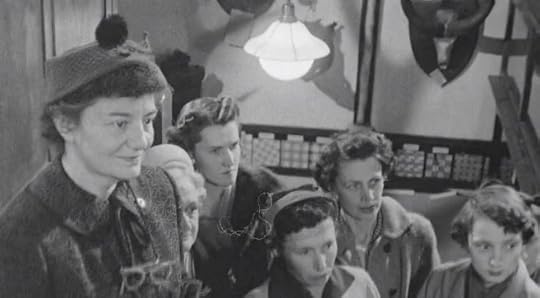
A local fundraising group tours the museum
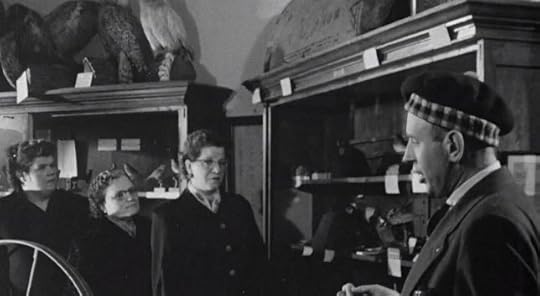
Mr. Appleby, the Museum Curator, played by Clyde Bell, provides a guided tour of the museum
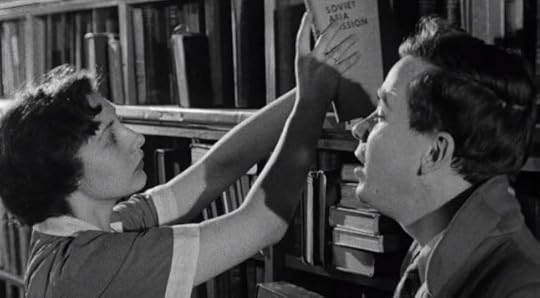
Harry Raddall, reporter, played by Richard Lamb, tells lovely librarian, Helen Tate, played by Joy Lindop (Cunningham), about his plan to sneak into the library late at night and photograph the museum’s fanged skull

The fundraising group concludes their tour with the curator

Reporter, Harry Raddall, played by Richard Lamb, sneaks into the Museum at night, under the cover of darkness…to photograph the skull
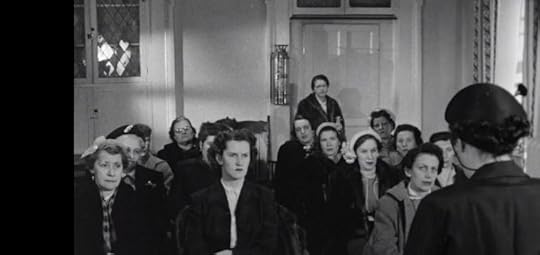
The shocking newspaper headlines are revealed at a fundraising meeting, “Skull With Fangs Declared a Hoax!”
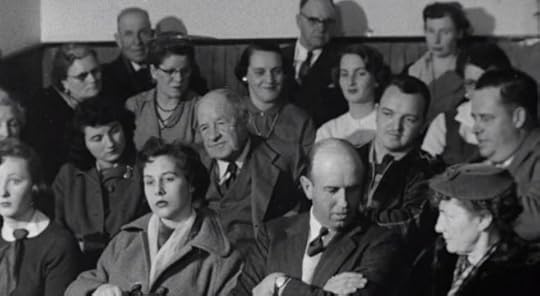
A Town Council meeting is held at the Perth Town Hall to decide whether the museum will receive funding

Professor Goddard, played by Peter Hopkinson, examines the skull to establish authenticity

Is the skull real? Or is it a hoax?
“The Hoax”
This delightful short film, just over 28 minutes in length, is a wonderful glimpse into the past, with many scenes of Gore Street, Perth, Ontario, as it appeared in 1955.
The local cast of actors did a fine job in their roles, many with memorable performances.
This historic film short may be viewed in its entirety on the National Film Board’s website, and is a must-see for local history buffs, capturing scenes of the main street of Perth as they appeared in the mid-1950s.
Enjoy!
View “The Hoax”
on the National Film Board site: https://www.nfb.ca/film/hoax/
(All Images are from: “The Hoax”, a movie by the National Film Board of Canada, produced in 1955.)
Director: William Davidson
Story and Screenplay:Norman Klenman
Photography: Robert Humble
Sound: Clifford Griffen
Editing: Douglas Robertson
Production: Nicholas Balla
Cast:
Harry Raddall, Reporter: played by Richard Lamb
Helen Tate, Librarian: played by Joy Lindop (Cunningham)
Mr. Appleby, Curator: played by Clyde Bell
Professor Goddard: played by Peter Hopkinson
Mrs. Tate: played by Mrs. T.A. Rogers
Vic Edwards, Newspaper Editor, played by Victor ‘Vic’ Lemieux
Also featured in ‘The Hoax”:
Vince Lally, Jo Keays, Jack Finnegan, Edna Coutts, Mayor Scott Burchell, John Mather Town Clerk, Mr. ? Arbuthnot, Grace Grainger, Norm Turner, Mr. ? Sawdon, Mrs. ? Hamilton
(and many more)
Please comment below to help identify the local actors from the Perth area so they can be listed with the other members of the cast.

With thanks to the local cast and crew, and to the National Film Board of Canada, for capturing these moments in time, and preserving this special slice of history for the town of Perth, Ontario.
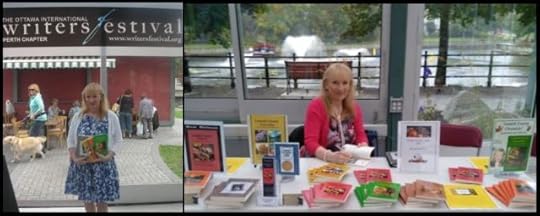
Arlene Stafford-Wilson
Member, Association of Professional Genealogists
Honorary Life Member, Lanark County Genealogical Society
Author of “Lanark County Kitchen”, “Lanark County Christmas”, “Lanark County Comfort”, “Lanark County Collection”, “Lanark County Calling”, “Lanark County Classics”, “Lanark County Connections”, “Lanark County Calendar”, “Lanark County Chronicle”, “Lanark County Kid”, & “Recipes & Recollections”
October 23, 2023
Ottawa Valley Disaster
On a cold and stormy November night, in 1912, the “Mayflower” sank into the frigid waters near Barry’s Bay. There were 12 people aboard, including crew members, and the only survivors were three travelling salesmen from Ottawa. The brave young salesmen clung onto a wooden coffin, part of the ship’s cargo, which stayed afloat, and they made it to a small island, and were rescued the following day. The other eight souls onboard perished.
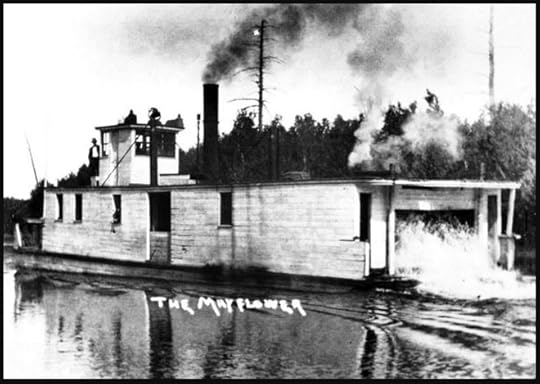
The Ship
The “Mayflower” was built in 1904, from oak, hemlock, and local white pine, on the shore, beside the Hudson Hotel in Combermere, Ontario, by Napoleon Tessier, of Hull, Quebec, for two brothers, John Charles Hudson and Henry Edwin Hudson. She had a length of 77′, a breadth of 18′, a depth of 4′ and height of 20′, and was powered by two steam engines. The “Mayflower” was nearly a flat-bottom boat, designed for navigating the shallow waters on the Madawaska River. A single rear paddle wheel was set into the stern and had twelve paddles. By 1912, the eight year old boat had not been well maintained, was not seaworthy, and was not certified for safe operation.
The “Mayflower” was used for transporting freight, mail, and also offered a limited passenger service between Barry’s Bay and Combermere, also Palmer Rapids, on the Madawaska River.
The crew of three included: Owner and Captain John Hudson, the Pilot and Wheelsman – Aaron Parcher, and the young Fireman and Engineer, Tom Delaney.
Because of very low level running-lights this ship was not designed to be on the water after dark. What was supposed to be the final run of the season took place earlier that same day. The ill-fated voyage would never have left the harbour if it wasn’t for the local Radcliffe Township Councillor, William Boehme, who persuaded Captain Hudson to make one final trip that evening to transport the corpse and coffin of a relative – John ‘Herman’ Brown, who had died five days earlier in Saskachewan, and had arrived that day by rail.
The 12 People Onboard
On Tuesday evening, November 12, at 7:00 p.m., the Mayflower left the harbour at Barry’s Bay. It was a bone-chilling night, with high winds, and blowing snow. This journey, at the usual speed of 5 – 7 miles per hour, normally took three hours.
There were twelve people including the crew, plus John Herman Brown’s casket onboard the boat when she left Barry’s Bay.
“The Mayflower left Barry’s Bay in the midst of one of the howling storms for which the month of November is noted.”
“A howling wind was sweeping down over the river, which is nearly a mile wide at the point where the boat sprang a leak, and the water was lashing the sides of the ill-fated boat with a vengeance. All around was black. Not a light could be seen anywhere. The boat began to lurch a little, a little more, and then terribly; then the old coal oil lamps went out by being crashed to the floor, and in a few minutes, when all was in darkness, the boat keeled over broadside and sank suddenly, throwing passengers, crew, freight and all, of which there was a good deal aboard, and machinery, into the icy water.”
Nov. 14, 1912, p. 3, “The Berlin (Kitchener) News Record”
3 Life Jackets
“On the deck, Captain John Hudson handed out the only three life jackets on board. It is said that Elizabeth McWhirter, age 83, refused to take one, expressing her desire to see a young person survive the ordeal. The captain ordered that the casket bearing John Herman Brown’s body be thrown overboard. Then he ran down towards the engine room where Engineer, Tom Delaney, was still at his post. With the ship keeling over, the passengers either jumped or were washed into the icy waters by the high waves which crashed against the hull.”
Nov. 12, 2012,”The Pembroke Observer”
The Crew
The Mayflower had a crew of three:
Captain John Hudson
Capain John Hudson, owner of the ship, Mayflower, native of Brudenell, Renfrew County, age 46, was also Reeve of Radcliffe Township, and well respected in the community of Combermere. He was the son of John Hudson and Elizabeth Dennison, and at age 38, in 1904, he married Margaret ‘Maggie’ Mahon, in the town of Renfrew. In 1905, their only child, John ‘Edwin’ Hudson was born.
Aaron Parcher, Pilot
Aaron Parcher was the son of Cyrus Parcher and Mary Ann Knight. He was 28 years old at the time of the wreck, and was the Pilot/Wheelsman onboard the “Mayflower”. Five years earlier, at age 23, he’d married Maud McLean, and they had two young sons, Gordon, age 4, and Allen, age 2.
Thomas Delaney, Engineer
Little is known about Delaney, who was the Fireman on the “Mayflower”. “When the boat began to sink, he and passenger, William Murphy, clung onto the flagpole, according to Gordon Peverley, one of the survivors”
“As soon as Aaron Parcher realized there was danger he put on a life belt, which hung in the wheelhouse and hollered that he inteded to try and make for his father’s landing. He said he could get help there. I could see the flagpole of the boat sticking above water, and Delaney, the Fireman, clinging to it. We tried to get towards Delaney and Murphy who was also holding the flagpole. We got near to them and told them to make an effort to reach us. They were too exhausted to keep their hold any longer, gave up hope, and sank.”
Nov. 15, 1912, p. 2, “The Ottawa Citizen”
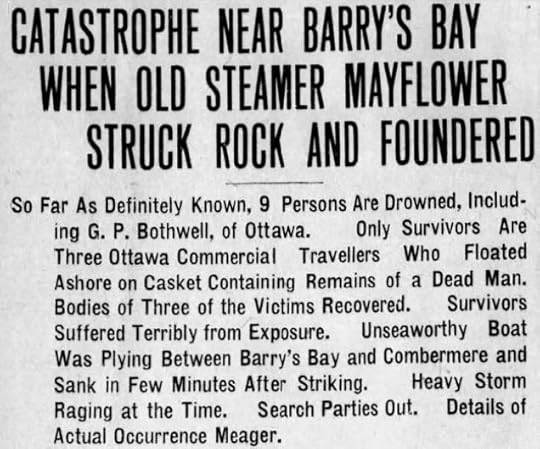
November 14, 1912, p. 1, “The Ottawa Citizen”

Google map – left section showing Barry’s Bay, Madawaska River
“The seventy-foot steamer, Mayflower, sank ten minutes after striking a rock in the river, about three miles from Barry’s Bay, en route to Combermere, a distance of sixteen miles.”

Nov. 14, 1912, p. 1, “The Ottawa Citizen”
“We were sitting in the engine room when suddenly the water came in
and the boat sank within fifteen seconds.”
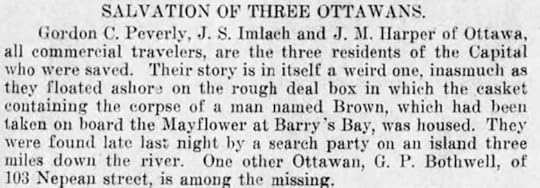
They clung to the casket, the only thing left floating, and made their way to one of the two islands in Kamaniskeg Lake.
“They clung onto the floating casket and set out to the island about 9:00 p.m. about 500 feet away”
Herman Brown
The body in the casket was that of John ‘Herman’ Brown (Braun), unmarried, age 29, (1882-1912), son of Herman Brown (Braun) and Augusta Groskalas. He died on November 7th, of an accidental gunshot wound in Yorkton, Saskatchewan. He was being transported back home, to the village of Schutt, in Renfrew County, his final resting place.
Robert Pachal
Robert Pachal, age 25, born in Ukraine, son of Friedrich Pachal and Wilhelmine Scheler, accompanied the body of Herman Brown, from Saskatchewan to Ontario on the train. Robert was married to Martha Brown, and they had a two year old daughter, Annie, at the time of his death.
“Robert Pachal’s body was found this morning on the shore of the island where the three survivors were found. He came from Yorkton, Saskatchewan with the body of his brother-in-law, Herman Brown, 30 years old, whose remains he was taking to Combermere.”
Nov. 14, 1912, p. 1, “The Ottawa Citizen”
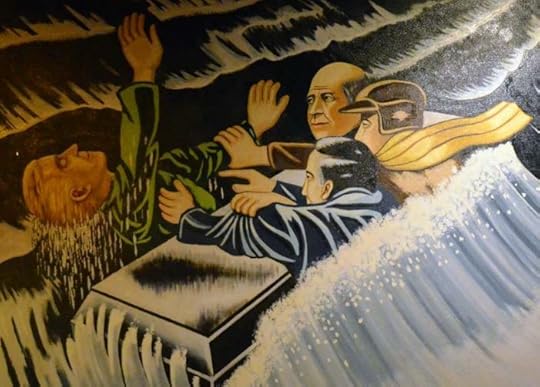

Nov. 14, 1912, p. 1, “The Ottawa Citizen”
“During yesterday’s examination the divers explored the bottom for 100 feet on either side of the steamer, then continued their search for Bothwell’s body.”
Nov. 18, 1912, p. 12, “The Ottawa Citizen”
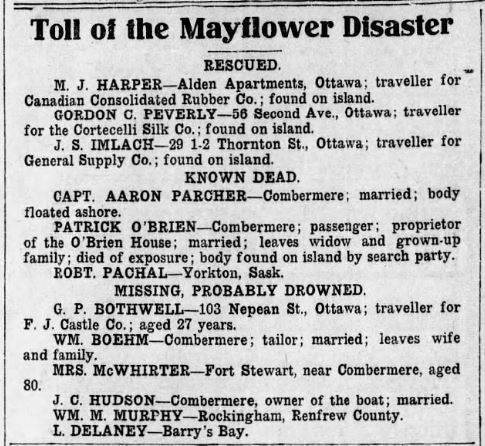
Nov. 14, 1912, p. 1, “The Ottawa Citizen”
Only 3 Survivors:
Harper, Peverly, and Imlach
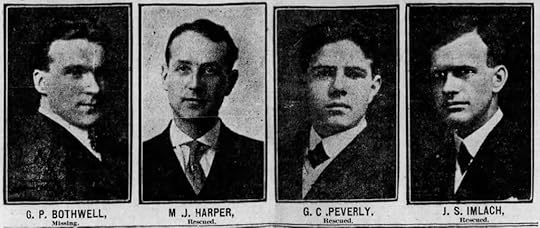
Nov. 14, 1912, p. 1, “The Ottawa Citizen”
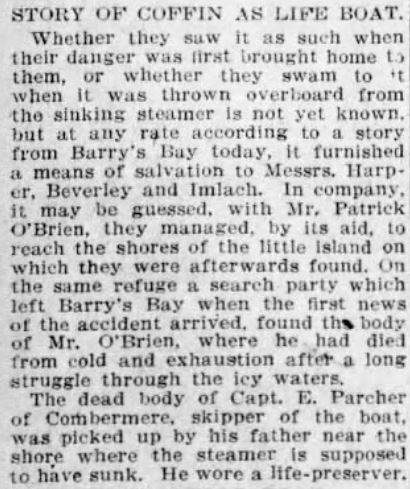
Nov. 14, 1912, p. 1, “The Ottawa Citizen”
How Were They Found?
“As hope began to fade, the 16-year-old son of Silas Parcher, and brother of the crew-member, Aaron Parcher, was walking near the shore with his gun, hunting partridges. He saw a body floating near, which looked like that of his brother. The boy hurried back to his father, who canoed out to find that the body was that of his son. Over on the shore of the island, Mr. Parcher saw what looked like somebody waving something white. He at once hurried to Combermere, six miles away, and there learned that the “Mayflower” was missing, and told what he had seen on the island”
November 18, 1912, p. 12, “The Ottawa Citizen”
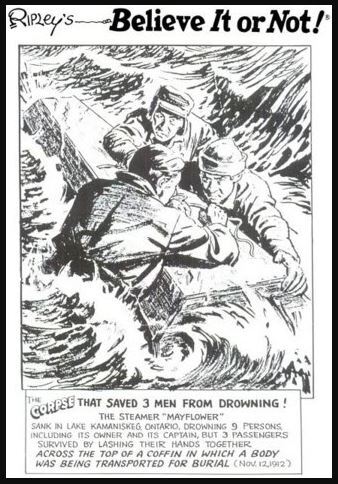 Ripley’s “Believe It or Not”
Ripley’s “Believe It or Not”The Rescue
Gordon Peverley, survivor, described the rescue: “The day wore on. Each tried to cheer the other up. Close at hand lay the body of Mr. O’Brien, and the coffin with the corpse of Herman Brown in it. Mr. Harper was the only one who had an overcoat and we shared it as best we could. All the time we kept asking one another what our opinion was about the fate of George Bothwell. We dared not believe he had perished. When darkness came we tried to keep our hopes buoyant by telling one another that the fire which we took care to keep going would attract the attention of the captain of a passing boat. It must have been nearly nine o’clock when we first heard the whistle of a steamer which we found later to be the “Ruby”. About 20 minutes later we heard the swish of oars and a chorus of voices say, “Hallo boys! Where are you, and how are you?”
Four More Bodies Found
“Word was received last night from Barry’s Bay that four bodies were found together, and all were either in or near the boat, an indication that it went down so quickly as to afford practically no opportunity of escape for most of the passengers.
The bodies located yesterday were those of Elizabeth (Storie) McWhirter, of Fort Stewart, Councillor, William Boehme, of Combermere, Engineer, Tom Delaney, of Barry’s Bay, and Captain John Hudson, of Cobermere. The first three bodies were found in the cabin of the Mayflower, where the victims had been drowned like rats in a trap. That of Hudson was some eight feet away from the bow of the boat.”
November 18, 1912, p. 12, “The Ottawa Citizen”
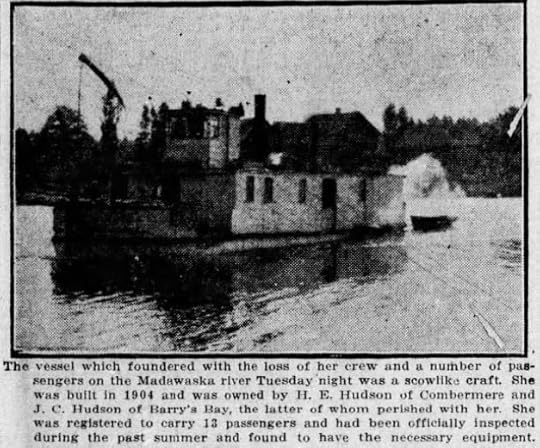
Nov. 14, 1912, p. 1, “The Ottawa Citizen”
William Boehme
William Boehme, born in Brandenburg, Germany in 1853, was a Tailor by trade. At age 32, he married Louise Frederick, in Wilberforce Township, and they had eight children: William (1897-1897) died in infancy, Annie (Dustin) (1888-1969), Herman (1890-1955), William F. (1891-1918), Charles (1892-1892), Hubert Arthur (1894-1894), Female not named (1896-1896), Female not named (1897-1897), only three survived to adulthood.
It was later reported that it was William Boehme, a local Township Councillor, who persuaded Captain John Hudson to embark on one last trip for the season, at 7:00 p.m., to pick up the body of his relative, John ‘Herman’ Brown, from the Grand Trunk Railway station in Barry’s Bay, to be transported home and buried in the village of Schutt before winter. Brown died as a result of a gun accident in Yorkton, Saskatchewan.
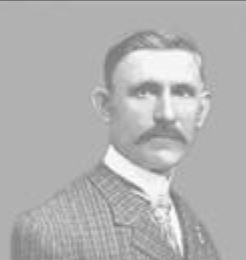
Councillor, William Boehme
Three of the men on the “Mayflower” were politicians.
Captain John Hudson was Reeve of Radcliffe Township, and William Boehme and Paddy O’Brien were both Township Councillors.
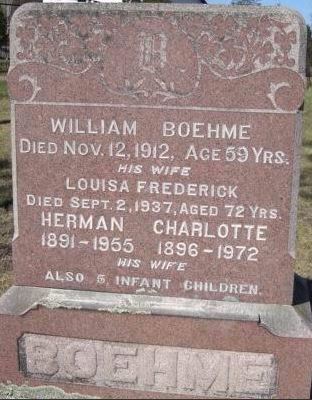
Combermere Methodist Cemetery, Renfrew County
“At the wharf were the wives and families of Paddy O’Brien and William Boehme. They inquired anxiously for news of their loved ones. On hearing the worst they turned away to their homes shaking with sobs. Both Mr. Boehme and Mr. O’Brien were well respected in the village where they lived and both were members of the village council. The late Captain Hudson was the Reeve. All were married men with families.”
November 15, 1912, p. 1, “The Ottawa Citizen”
George H. Bothwell
George Bothwell’s body was the last to be recovered, and was not found until the spring of 1913, in April. His remains were found on the rocks on the east shore of the river, opposite to where the wreck occurred.
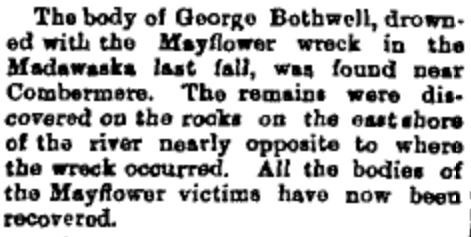
April 25, 1913, p. 8, “The Perth Courier”
George Bothwell, age 27, lived at 103 Nepean Street, and came to Ottawa in 1906 from Aberdeen, Scotland. In 1907 he began working as a Commercial Traveller for the F.J. Castle Company Ltd., a wholesale grocer. He had a regular route of the Barry’s Bay district on behalf of his company. He was not married.
Death Notice: BOTHWELL, George H., drowned on the steamer, “Mayflower”, on the Madawaska River on 12th Nov. 1912, body recovered Monday, April 21st, 1913. Masonic and semi-military funeral will be held on Thursday, 24th inst., at 2:30 p.m. from Roger’s and Burney’s Chapel at 283 Laurier Ave. W., Ottawa.
Elizabeth (Storie) McWhirter
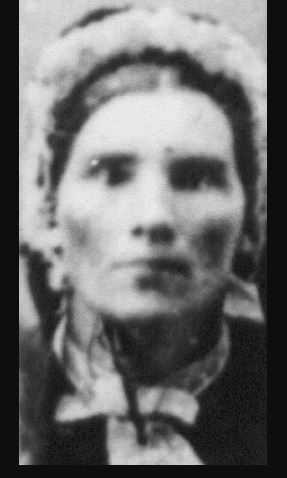
Elizabeth (Storie) McWhirter, the only woman aboard, was the daughter of Scottish immigrant William Storie, Kirkton, Scotland, and Mary Ann McQueen of Kilbirnie, Scotland. Elizabeth and her husband, William, (he died in 1911), had 8 children: Thomas Alexander McWhirter (1854-1935), Jannett McWhirter (1856-1881), Mary McWhirter (1859-1946), Catherine ‘Kitty’ McWhirter (1861-1953), Agnes McWhirter (1862-1958), William Joseph McWhirter (1864-1942), Elizabeth ‘Lizzie’ Stewart McWhirter (1869-1962), and Robert McWhirter (1873-1875)
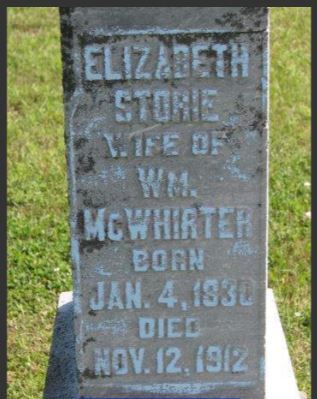
Patrick ‘Paddy’ O’Brien
Paddy O’Brien, son of John O’Brien and Bridget McNamara, drowned at age 60, (1853-1912), he owned one of two hotels located in Barry’s Bay – O’Brien House Hotel.
Born in Pakenham, Lanark County, Ontario, he married Matilda ‘Tilley’ Price, and they had a large family: Maggie, Charles, Howie, Matilda, Patrick, Mildred, Sarah, Walter, and Clara.
At the time of his drowning, most of the children were grown, and their youngest daughter, Clara, was 18.
“Mr. O’Brien made a great effort to reach shore, he was in the water swimming for upwards of two hours, but a few minutes after reaching the shore, died from exhaustion.”
November 14, 1912, p. 2, “The Ottawa Journal”
After Paddy’s death, his wife, Tilley, continued to run the O’Brien Hotel, with the help of their sons, Howie and Walter.
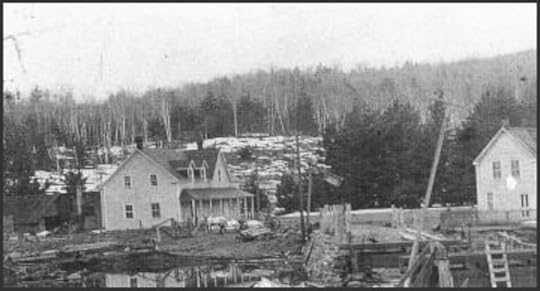
O’Brien House Hotel – 1911
The O’Brien House Hotel was established circa 1880’s, was one of only two hotels in the area, along with Hudson House. The O’Brien Hotel had the first telephone exchange in the area and was used to communicate information to Barry’s Bay in the days after the sinking of the Mayflower.
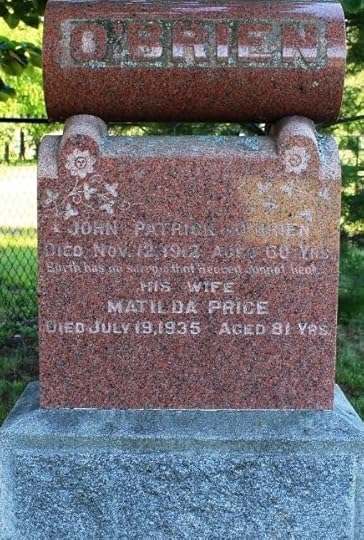
Patrick O’Brien and his wife, Matilda Price O’Brien – Combermere Methodist Cemetery
William Murphy
William Murphy, Irish, age 55, was not scheduled to be on the “Mayflower” on that stormy November night. He was a labourer, and unmarried, and it was only by chance that he decided to go on that fateful voyage.
The Survivors:
Joseph Harper
Joseph Harper, son of Joseph Harper and Matilda Elliott, was born in Forrester Falls, in 1884, and at the time of the shipwreck, at age 27, he was employed with the Dominion Rubber Company in Ottawa, as a Commercial Traveler. He was still a newlywed, having married a Smiths Falls girl, Nellie Ferguson, in June of 1911. They moved to Ottawa that same year, to 207 O’Connor Street. He was employed with the Dominion Rubber Company until his retirement in 1955, and then moved to Almonte. Joe and Nellie had four children: John, George, Betty (Guselle), and Noreen (MacDonald), and at the time of his death in 1957, they also had 11 grandchildren. Joe is buried at the Auld Kirk Cemetery in Almonte, Ontario.
John Imlach
John Stevenson Imlach, born in Carleton Place, Ontario, was one of the three survivors of the wreck of the Mayflower. At that time, in November of 1912, at age 27, he was still a bachelor, living with his parents, at 29 Thornton Avenue, Ottawa. He was a machinist and traveling salesman for the General Supply Company, Ottawa. His brother, Andrew Imlach, was founder and proprietor of the Victoria Garage Company.
“When news arrived of the disaster, Andy Imlach, immediately rushed to Thornton Street and cut the telephone wires so that no news could come through to his mother, until they were certain of his brother’s fate. Not ’till he was in possession of certain intelligence of his brother’s safety that he let his mother know there had been any danger.”
Nov. 14, 1912, p. 2, “The Ottawa Journal”
Four years after the disaster, in the summer of 1916, John Imlach, age 31, fell in love, and married Evelyn Louise May Ready, a schoolteacher. In 1926, they had a daughter, Shirley Isobel Imlach.
Gordon Peverley
Gordon Peverley, son of Clavering Peverley and Jenny Thompson, was born in Quebec in 1884, and was married at age 21, in Montreal, on June 20, 1906, to Mabel Herbert. At the time of the shipwreck, Gordon was 28, and he and his wife lived at 56 Second Avenue, Ottawa, with their two children, Gordon, their eldest, age five years, and baby Howard, who was just five months old. Gordon was a traveling salesman for the General Supply Company, and was doing his usual sales calls in the Barry’s Bay area. When his wife first heard about the Mayflower, it was reported that “all hands were lost”, but she refused to believe that Gordon had perished, insisting that he was a powerful swimmer. She was overjoyed when she heard the news that he had survived. At age 34, Gordon and his family moved to Halifax, where he continued his career in sales. He passed away in 1955, age 70, in Cape Breton. Gordon and Mabel had six children, four who survived to adulthood: Gordon (1907-1989), Harold (1912-2000), Dora (MacDonald) (1915-2013), John (1917-1917 born premature), and Isabelle (Spencer) (1920-1993).
The Inquiry
There were so many reasons that the “Mayflower” should not have taken that final trip of the 1912 season. None of the crew members were licensed, and none had any formal training or certification papers to perform their duties. There were rumours and gossip after the disaster that members of the crew had been drinking at a local hotel before commencing the journey. The “Mayflower” had not been inspected, and was not cleared for operations to transport freight nor passengers. There were only three life-jackets onboard, and no lifeboat. The ship was not equipped with lights sufficient for an evening voyage on a dark November night. There were also reports that it was not the first time the “Mayflower” went down in the waters of the Madawaska River.
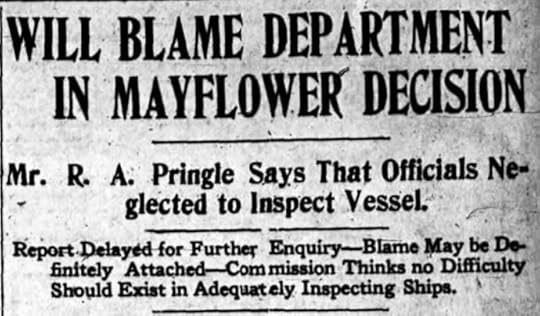
Dec. 31, 1912, p. 1, “The Ottawa Citizen”
The official inquiry blamed the government department for neglecting to inspect the ship.
Mr. R.A. Pringle was the Commissioner appointed by the government to head the inquiry into the “Mayflower” wreck. The Minister of Marine and Fisheries, Hon., J.D. Hasen, asked that they “pursue every possible course to discover where the fault lies and to ascertain why the ship was permitted to run without having complied with the law.” Evidence showed that the ship had no qualified ‘Master in charge’, and that it had no life-boat. Although the total number of ships subject to inspection is unquestionably large, “it is the duty of the government inspectors to see that the small percentage that fail to pass are prevented from running until there is the fullest compliance with the Shipping Act.”
The Tribute
The communities of Barry’s Bay and Combermere marked the 100th anniversary of the sinking by unveiling two new plaques in 2012,- one at the Barry’s Bay wharf, and a second plaque at the Combermere dock, paying tribute to the passengers and crew.
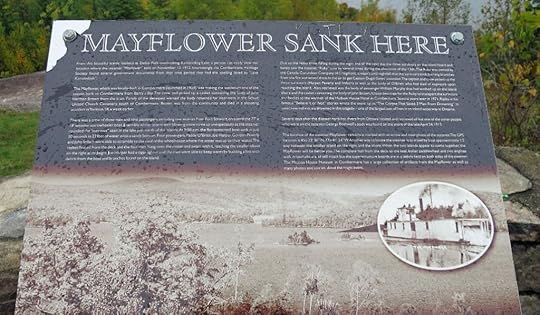
Close-up view of the inscription:
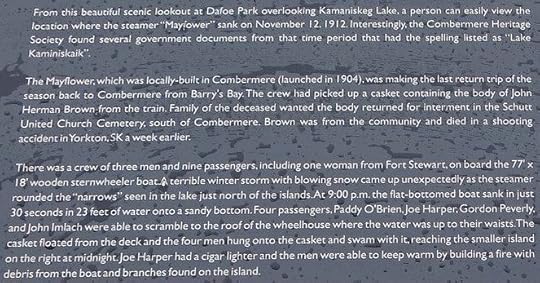

Final Note:
The sinking of the stern-wheeler, “Mayflower”, marked the worst inland maritime disaster in Canadian history of that time. Today, the story of the “Mayflower”, is a legendary part of the history of the Ottawa Valley.

Arlene Stafford-Wilson
Member, Association of Professional Genealogists
Honorary Life Member, Lanark County Genealogical Society
Author of: “Lanark County Kitchen”, “Lanark County Christmas”, “Lanark County Comfort”, “Lanark County Collection”, “Lanark County Calling”, “Lanark County Classics”, “Lanark County Connections”, “Lanark County Calendar”, “Lanark County Chronicle”, “Lanark County Kid”, & “Recipes & Recollections”
October 20, 2023
Irish Wakes
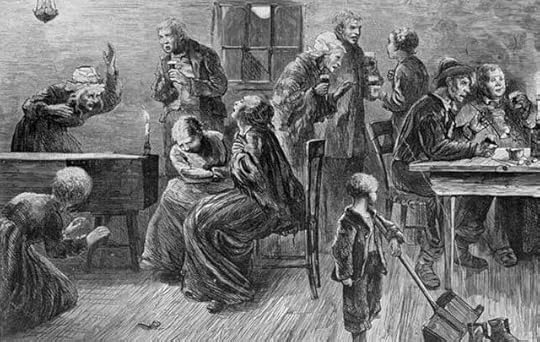 Depiction of an Irish wake – 1873
Depiction of an Irish wake – 1873Traditions of the Irish Wake
“The terrible thing about dying is
that you miss your own wake”
David Allen, Irish Comedian
Traditions seem to go on forever in small rural communities. They are passed down from father to son, and from mother to daughter. The tiny community of Ferguson Falls was settled by seven Irish bachelors and their story was told and re-told through the ages, so it wouldn’t be forgotten. When these young men landed from the old country in the early days they made a pledge to help each other to succeed in the new land, and if even one of them failed to thrive they would all return to Ireland. They were Patrick Quinn, John Quinn, James Carberry, William Scanlan, Terrence Doyle, John Cullen and James Power.
Around the same time my own ancestors arrived – the Stafford and the McGarry families, from County Wexford and County Westmeath, and the Irish-Catholic community grew and prospered in this idyllic community along the Mississippi River in Drummond Township.
In those days it was unusual and even frowned-upon to marry outside of one’s religion, and so the traditions and customs brought from the old country remained firmly entrenched in these early settlers and their families and were passed down for generations. It’s not surprising that many of these practices were still taking place in the 20th century, some with pagan Celtic origins, some more religious, and some so ancient they could no longer be explained.
As a young girl I heard stories, mostly from my father, who grew up near Ferguson Falls, and also some vivid tales from some of the old timers in the area. Some of their most colourful accounts included stories about their Irish wakes.
I remember my father telling me about his uncle’s wake, held in the family home, as was the custom. He said that the wakes were another excuse for people to get drunk, maybe a little drunker than usual, and they did some things that were almost unspeakable. He recalled his deceased relative being ‘laid out’ on the dining room table and that late at night two of the intoxicated guests attempted to pour whiskey down the dead man’s throat.
Many years ago, I also heard from one of the old-timers, James ‘Jim’ Quinn, a direct descendant of one of the seven Irish bachelors, that the standard rate to dig a grave was a bottle of whiskey. The usual amount was twenty-six ounces and was split between two men, who dug the graves by hand at St. Patrick’s cemetery. He was, in fact, according to him, one of the two who dug the grave for my great uncle Jimmy Richards, and the lads were paid in the usual way, a bottle of whiskey, from my great aunt Tessie Richards, the departed’s sister.
The ‘Third Birthday’
The eldest ones used to refer to death as ‘the third birthday’. They claimed that the first birthday was the day you were born, and the second birthday was your baptism. The third birthday is the day you pass away, and should be filled with both mourning and celebration as you move from this life and enter Heaven.
Stop the Clocks

All clocks in the house are stopped at the hour of the death as a sign that the passage of time has ended for the departed. Time stands still for them, and a new period of existence begins, without time. It was believed that if time continued to move ahead that this invited their spirit to remain in the home rather than moving on. Some say it was also a way to mark the time of death. Others claimed it is done so mourners will stay as long as they please without worrying about the time.
The Open Window
Immediately after the death, the window closest to the deceased is opened for two hours. The open window allows the spirit to leave the body. No one must stand near nor block the path to the window as it might prevent the spirit from leaving, and will bring misfortune to any person who blocks it. After two hours have passed the window is closed so that the spirit doesn’t attempt to re-enter the body.

Close the Curtains
With the exception of the open window closest to the deceased, all other windows are to be closed, and the curtains should be drawn until the body is removed from the home for burial. It was thought that if a moonbeam shone through a window at night that evil spirits could come in and try to steal the deceased’s soul.
Photographs Turned Face-Down
Family photographs were turned face-down so that the people in the pictures would not be spirited away with the deceased.
Cover the Mirrors
All of the mirrors in the home were either covered with cloths, or turned backward, facing the walls. There were two reasons behind this custom – that the deceased’s spirit doesn’t see their physical body in the mirror as they leave the home, and so that their spirit doesn’t get trapped inside the looking glass.
Mourning Cards
In the old days people kept black-bordered funeral stationary in their homes. Shortly after the death occurred, they wrote an announcement by hand, on a full sheet, enclosed it in black-bordered envelope and pinned the notice with a thumb-tack to the outside door. A black ribbon was also hung on the door. Neighbours could stop and read the announcement and learn of the date and times of the wake and funeral. A note at the bottom of the page encouraged neighbours to spread the news. A call was placed to local printers to order formal funeral cards, which included information about the deceased, and sometimes a photo or a prayer. The Mourning cards were also known as Prayer cards or Holy cards. Local newspapers were called and orders for obituaries were placed. The Mourning cards were available at the wake and at the funeral and given as a keepsake for the mourner to bring home with them.

Traditional Mourning stationery
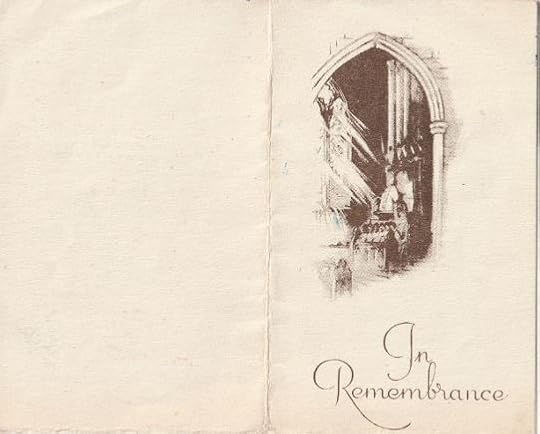
Mourning card – Anastasia ‘Stacy’ Richards Stafford (my grandmother) 1954
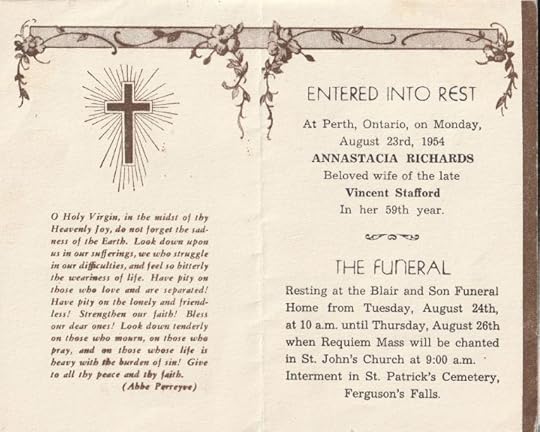
Anastasia ‘Stacy’ Richards Stafford – Mourning card – 1954
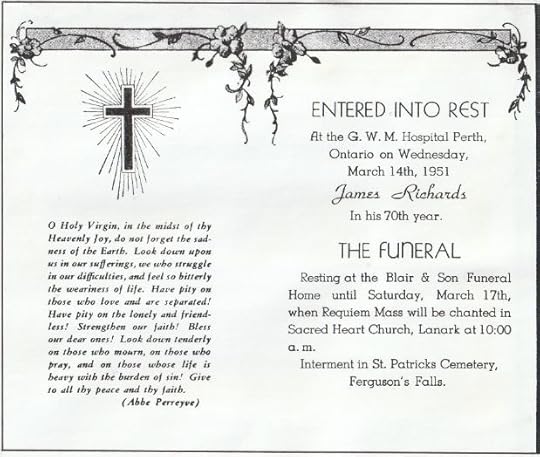
James ‘Jimmy’ Richards – Mourning card – 1951 (Jimmy, my great-uncle, was a farmer in Ferguson Falls and well-known local musician who played his fiddle regularly at the infamous Stumble Inn along the Mississippi River at Ferguson Falls)
Preparation
The body of the deceased was washed with Holy water, and dressed in their best clothing. There were often older women in the community who performed this task for the families, and were offered whiskey or food as payment and thanks. Men were shaved and both men and women had their hair combed and arranged nicely. Conservative dress was expected for the deceased and bright or pastel colours were not considered appropriate. The bodies were laid out on top of white sheets, usually on a long flat surface, such a dining room table. In Catholic homes rosary beads would be wound around the hand, with the crucifix laying on the person’s chest, close to their hearts. Once the body was prepared the deceased was never left alone in the room. At least one person must remain, and usually there were groups of people who remained awake through the night with the dearly departed. This custom of remaining awake is the origin of the term ‘wake’.
Candles
In some families white candles were placed all around the table where the deceased was laid out, however some families used only 4 candles placed around each of the four corners of the table. Candles were to remain lit (replaced as needed) until the body left for the funeral. It was bad luck to let one of the candles burn out and they were replaced as they burned down close to the end of the wick. The candles used at wakes were said to have healing powers, and the butts of the used candles would be saved and rubbed on burns and cuts.
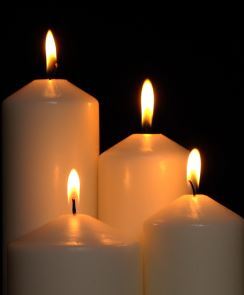
Keening
Keening comes from the Gaelic word meaning ‘to cry’. Women from the neighbourhood would gather at the wake and sob. There were even professional keeners who could be hired to cry at wakes. The art of keening originates from the Irish Banshees who shrieked and screamed foretelling a death. It’s been said that every family of Irish origin has their own Banshee, and that they even traveled with families across the ocean to the new world.
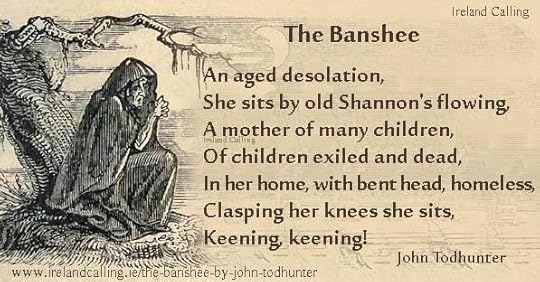
John Todhunter, Ireland Calling
What to Expect
If you’re planning to attend an Irish wake, then be sure to bring a little something for the family. Food, flowers or something to drink is always welcome, and a bottle of good spirits is always appreciated.
Although there is no dress code, wearing black or somber colours is a sign of respect to the family.
After a brief viewing of the deceased, you may pay your respects to the family with a few words, like: “Sorry for your troubles.”, or “Sorry for your loss.” It is a stressful time, and it’s not as important what you say, but more that you showed respect by attending.
The time you spend at the wake can be brief, as little as fifteen or twenty minutes, if you didn’t know the deceased very well. The busiest time will be the evenings, after suppertime, between 5 p.m. and 8 p.m. Neighbours, good friends and family members will remain at the wake for four to five hours, and the closest will stay all night, at least one night, in the room where the deceased is laid out.
The Food and Drink
After the wailing is over, the more social aspects of the wake begin. Food and drink for visitors are provided by the family, and it is customary for guests to bring a bottle of spirits, or some food for the wake. Shepherd’s Pie, Irish Stew, Corned Beef and Cabbage, cold cuts, and small sandwiches are common at wakes. Tea is served in fine china cups, and whiskey, beer, and wine are the most popular drinks, although any spirits will do.
Raise a Glass
It’s customary during the wake to raise your glass and toast the deceased. You might begin the toast by telling a little story about your friendship, or something amusing that happened, that the two of you shared. Some of the most popular Irish toasts at a wake: “May he rest in peace.”, “Gone, but not forgotten.”, “No one spread more love in a lifetime.”, “To absent friends.”, “To our friend who has gone on before us.”
The Smoking of the Pipe
A long-standing tradition is the custom of smoking from clay pipes. These small pipes were filled with tobacco for visitors to the wake house to take. Visitors lit the pipe and took a draw, exclaiming “Lord have mercy on their soul”. Non-smokers were also expected to partake of the ritual and in some cases snuff was also taken. After the funeral, the family broke the wake-pipes in two and buried them outside.
The Story-telling
It wouldn’t be a proper Irish wake without telling stories or reciting poems about the dearly departed. Fond memories are shared and become more animated and exaggerated as the whiskey flows throughout the days and evenings. There are stories of the school years from former classmates, and stories of the departed’s years of work, and about their trade or profession. Family stories and memories are shared with guests, with highlights of a life well-lived, and special anecdotes of their days on the Earth. Fiddles and flutes are played and songs are sung, jigs are danced, and stories continue throughout the days and evenings.
At midnight, the Rosary is said, concluding with: “Pray for us now, and at the hour of our death.” The neighbours, friends, and other guests leave the home, with only those closest to the departed remaining.
Some family members and dearest friends will stay all night in the room with the deceased. The stories and the drinking will continue overnight, and a new group will relieve them in the morning so they can get some rest. It is usual to wake for two to three nights before the funeral. The reason for waking at least two nights goes back to the very old times, and was to allow time in case the person was merely unconscious.
The Funeral
On the third day of the wake, the body is placed in a coffin and carried out of the home, always feet first, in order to prevent the spirit from looking back and beckoning another member of the family to join them.
Once the departed has been carried from the home, the mirrors are uncovered, the curtains pulled back, and the photographs are displayed again.
Exactly six pallbearers carry the coffin, and there should be 6 handles on the casket, three on each side, in remembrance of the Holy Trinity: Father, Son, and Holy Ghost. It isn’t always the case these days, but that is the Irish tradition. It is also thought to be bad luck to go home the same route as the one used by the funeral procession.
The funeral is usually held in church, and after that everyone proceeds to the cemetery. A short graveside service will be conducted by the priest.
Rain is a Blessing
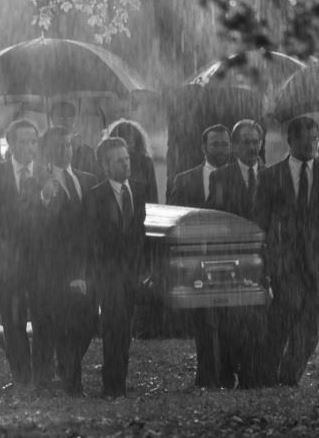
Rain the day of the funeral is a sign of a blessing, and if you hear a thunder-clap it means that the deceased has arrived in heaven.
After the funeral, everyone will be invited back to the house, to a bar, or community location for some food and drinks to toast to the deceased and honour their memory together for one last time.
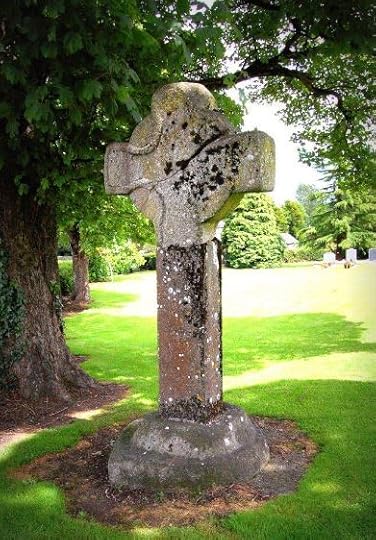
Many of the traditions of the Irish wake live on today, depending on where you live. Some customs have been adapted for modern times, and some of the old ways passed down through families, are strictly followed, as they were in days gone by.
“Grant them eternal rest, O Lord,
and may the souls of the faithful departed,
through the mercy of God, rest in peace.
Amen.”

St. Patrick’s Church, Ferguson Falls, Ontario, Canada, est. 1856.
“But since it fell into my lot
That I should rise and you should not
I’ll gently rise and softly call
Good night and joy be to you all
So fill to me the parting glass
And drink a health whate’er befalls
Then gently rise and softly call
Good night and joy be to you all.”
“The Parting Glass”, written by Trad / David Anthony Downes
Sources for “Irish Wakes”
Delaney, Mary Murray. Of Irish Ways. Dillon Press, Inc, 1973
Staffords Funerals, website, Dublin, Ireland
Bourke.A (1988), The Irish Lament and the Grieving Process, Women’s Studies International Forum, Vol.11, No.4
Danaher.K (1962), In Ireland Long Ago, Mercier Press.
Lysaght.P (1988), Caoineadh os Cionn Coirp: The Lament for the Dead in Ireland, Folklore 108.
About the Author:
Arlene Stafford-Wilson
Arlene Stafford-Wilson was raised on a small farm in Bathurst (Tay Valley) Township. Her Stafford and McGarry ancestors left southern Ireland, and arrived in Lanark County in 1816. She also descends from the McKittrick, Waters, Doyle, Carroll, and O’Keefe families, also from southern Ireland.
Honorary Life Member, Lanark County Genealogical Society
Member, Association of Professional Genealogists
Author of : “Lanark County Kitchen”, “Lanark County Christmas”, “Lanark County Comfort”, “Lanark County Collection”, “Lanark County Calling”, “Lanark County Classics”, “Lanark County Connections”, “Lanark County Calendar”, “Lanark County Chronicle”, “Lanark County Kid”, & “Recipes & Recollections”
 Arlene Stafford-Wilson
Arlene Stafford-Wilson*

*
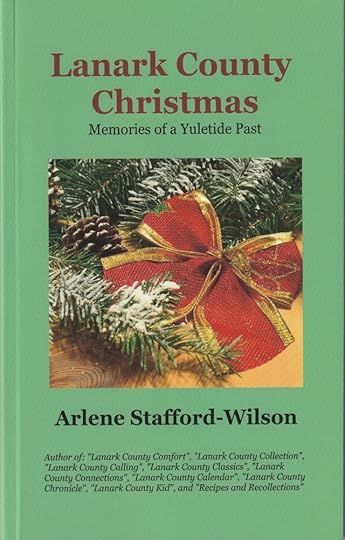
*

October 19, 2023
Irish Settlers & the Ghost of Burgess Township
The story of the Burgess Ghost begins with the arrival of so many Irish to the areas around Westport, the Scotch Line, Black Lake, and Stanleyville, that it became known as the ‘Irish Invasion’.
This is the the home where the story took place, in the cold, bitter winter of 1935, at the home of Mr. John Quinn. John lived in the house with his wife, and two sons Michael age 13, and Stanley, 11.
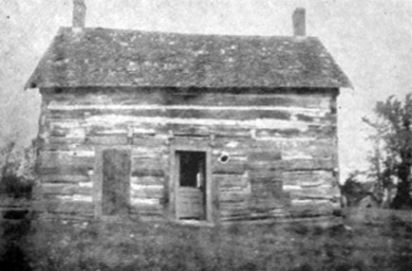
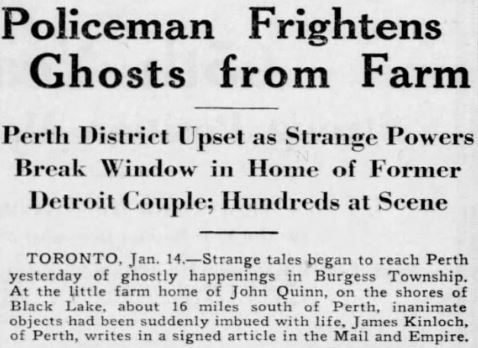

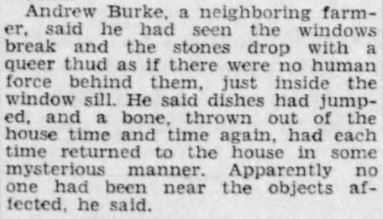


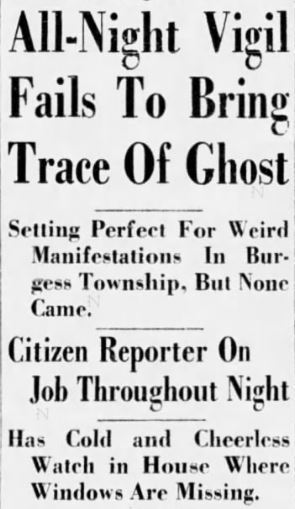
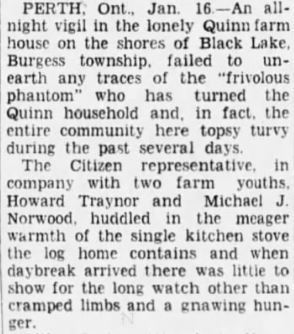
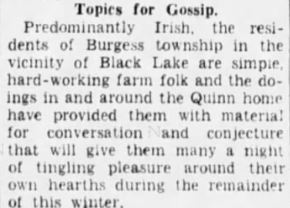
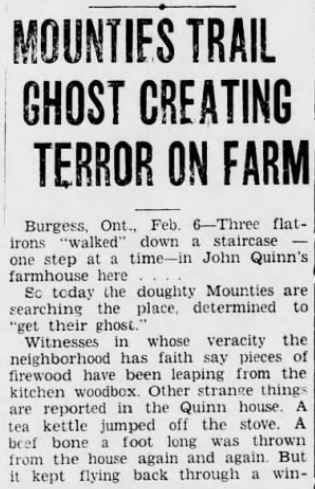
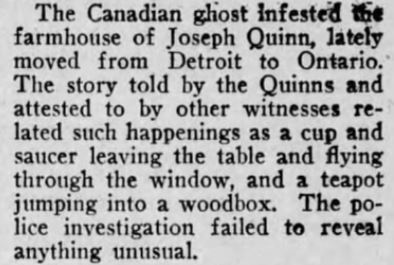
“Strange occurrences were happening in 1935 at a farm in North Burgess just off the Narrows Locks road. Mr. John Quinn, his wife and two children, Michael, and Stanley, ages 13 and 11, reported innumerable phenomena taking place in their home. Stove lids, according to the Quinns, “danced” in the air, the teapot “jumped” off the stove into the wood box, three flat irons “walked” down a staircase and dishes “pranced” on the dining-room table. Word of this mysterious goings on spread quickly throughout the district. Although, perhaps skeptical, hundreds of persons from miles around flocked to the Quinn home.
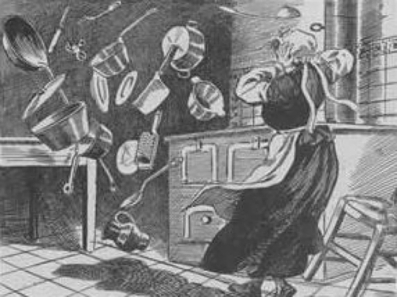
On the Sunday after the reporting of the “ghosts” more than 100 cars arrived at the Quinn farm. Along with the cars a flotilla of cutters and sleighs dotted the white-capped farm. The snow fell incessantly and the thermometer dipped way below the zero mark.
Newsmen from across the country arrived, and the CBC news from Toronto, reported the strange events. Although the strange occurrences could not be readily explained, many held doubts in their minds as the credulity of the phenomena. Believing that there had to be a reasonable explanation behind the occurrences, the Perth detachment of the OPP decided to hold an investigation.
On a Saturday afternoon, members of the force motored to the Quinn home, and inspected the building. Nothing strange occurred while they were there. That same evening Inspector Storey returned to the house. He remained there until Sunday morning along with about a dozen district men, sat in the house, speaking in hushed tones, but again nothing happened.
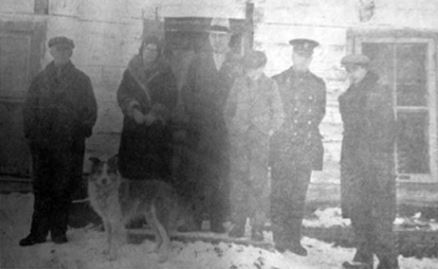
Mr. Quinn was unable to explain the strange occurrences that had been going on for the past couple of weeks. Pieces of beef he had placed in a barrel had been found littered throughout the house, he said, and the Wednesday before a window pane crashed for no apparent reason. He had not thought that too odd until it happened the very next evening.
Andrea Burke, a neighbouring farmer, declared that a bone thrown out of the home time and time again had always returned to the house for no explicable reason. Another neighbour, William Cordick, swore that he had seen three flat irons descend the Quinn’s staircase one after another.”
………………………………………………………………………………………………………………………………………..
Irish Settlers to North Burgess Township, Lanark CountyMost, but not all of the Irish in North Burgess Township, came from County Down and County Armagh, and many came in the 1840s, to escape a horrible famine, that swept through Ireland like an unstoppable plague. A disease called Potato Blight ravaged their crops for nearly a decade, and during that time over a million died of starvation, and an equal number fled Ireland on ships sailing to Canada and the United States.

Most were tenant farmers, leasing their land; unable to pay their rent when their crops failed, and were evicted by ruthless landlords. They bundled up what little they had, and boarded ships headed for the new world.
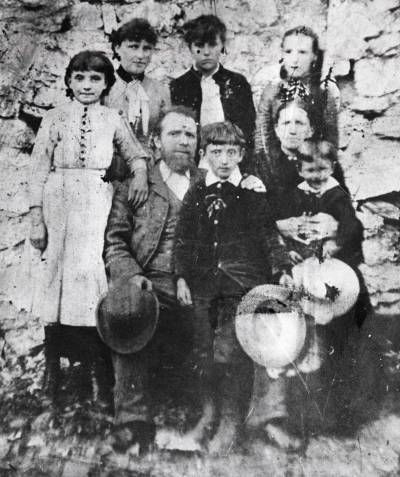
Seven weeks was the average length of time spent at sea, and the conditions endured by these Irish immigrants were so terrible that the ships were nick-named ‘coffin ships’. The lice, ticks and fleas common in these over-crowded vessels were the ideal breeding grounds for the transmission of disease, and by 1847 an average of 50 passengers died each day of typhus on their voyage from Ireland.
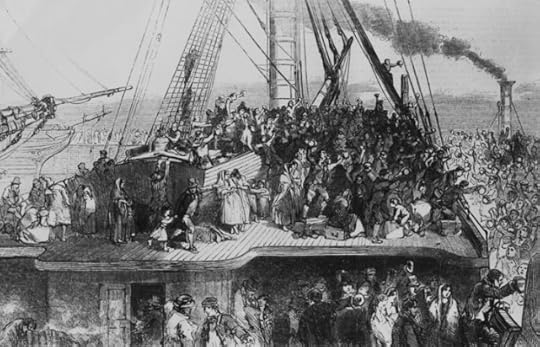
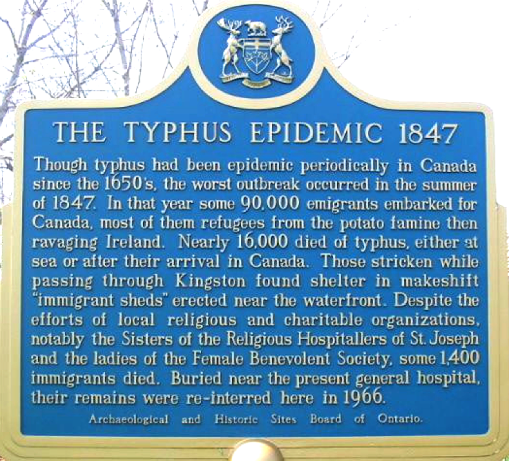

These new settlers brought their traditions, customs, and stories with them to the new country. Stories and legends were passed down from father to son, and from mother to daughter. Tales from the old country were told in the evenings by the fire, and the one story that seemed to run up and down the concessions in North Burgess was the legend of the Irish Banshee.

The Banshee, or ‘Bean Sidhe’ is an Irish spirit, and her high-pitched wail foretells of a death in the family. It was said that each family had its own Banshee, and that they travelled with them from the old country. Some said that the family’s Banshee would stay in Ireland at the family’s estate, and mourn the dead. The settlers to the new land brought their vivid descriptions of the Banshees – some claiming that she was an old hag with red eyes, but others said she was a fair, pale Irish beauty with long red hair dressed in a flowing gown.
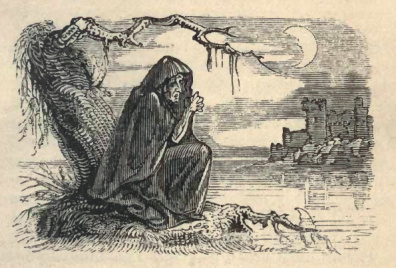

It’s been said that whoever hears her high and piercing shriek could be sure that there would be a death within 24 hours. Irish lore tells that the Banshee always wailed when a family member dies, even if the person had died far away, and news of their death had not yet come. The wailing of the banshee was the first warning to the household of the death.
When several banshees appeared at once, it was said to foretell of the death of someone prominent, or of an accidental or unintended death – often of a murder victim, a suicide, or a mother who died in childbirth.
The early settlers in North Burgess passed down their stories of banshees, fairies, ghosts and the little people. Although they were fiercely loyal to God and to the church, they never abandoned their beliefs in the spirits and creatures of their ancient folklore.
The Story of the Burgess Ghost became a local legend….The story of the ghost in the Quinn house was passed down through the years, told and retold at family gatherings, around campfires, and particularly in the weeks each year leading up to Hallowe’en.
In a strange final twist to the mystery of the Burgess Ghost, the Quinn family home burned to the ground. The cause of the fire was never determined, and remains a mystery to this day…..
In 1972, the Quinn home was burned to the ground.

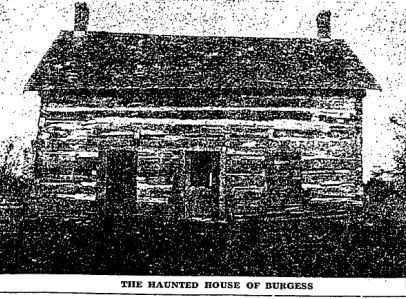
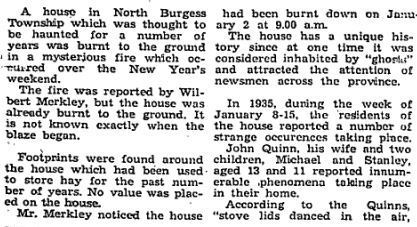
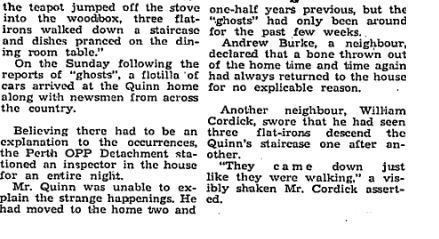
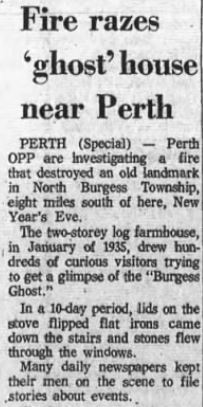
………
In 2002 the townships formerly known as North Burgess, South Sherbrooke and Bathurst were part of an amalgamation, and adopted the name of Tay Valley Township, as they are known today.
……..
For genealogical records of the founding families of North Burgess Township:
http://www.rootsweb.ancestry.com/~onlanark/nburgess.htm
St. Bridget’s Cemetery Staneyville Ontario
Roman Catholic interments North Burgess Township
Scotch Line Cemetery – Burials from 1822-2000 North Burgess Township
Scotch Line Cemetery – North Burgess
Lanark County Genealogical Society
Archives Lanark
http://archiveslanark.ca/index.php
Search the census records for North Burgess Township, Lanark County
Searchable online census records for Lanark County
……………
For more information on Irish Folklore in the early days of Lanark County:
‘Banshees of Burgess’, is part of a collection of short stories in ‘Lanark County Classics – A Treasury of Tales from Another Time’. The reader will discover more about the early families from Ireland who settled in Lanark County, and their customs and beliefs in the supernatural, brought from the old country. The story explores some of the tales passed down by these Irish settlers, and documents their personal experiences with Banshees, ghosts, and fairies while living in Lanark County.
“Lanark County Classics” – ISBN 978-0-9877026-54
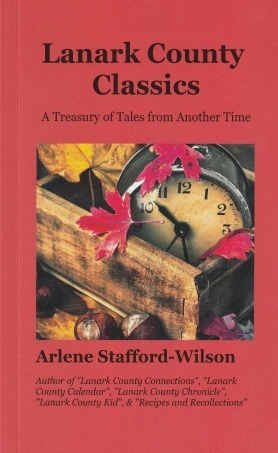
…..
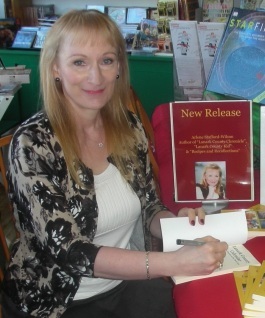
Arlene Stafford-Wilson
Honorary Life Member, Lanark County Genealogical Society
Member, Association of Professional Genealogists
Author of : “Lanark County Kitchen”, “Lanark County Christmas”, “Lanark County Comfort”, “Lanark County Collection”, “Lanark County Calling”, “Lanark County Classics”, “Lanark County Connections”, “Lanark County Calendar”, “Lanark County Chronicle”, “Lanark County Kid”, & “Recipes & Recollections”
note: (map of Northern Ireland – By Maximilian Dörrbecker (Chumwa) – map by NNW, CC BY-SA 2.5, https://commons.wikimedia.org/w/index.php?curid=7918534)October 18, 2023
Rideau Ferry’s Dark Legend

The legend of the notorious John Oliver begins in 1816 when he and his family settled on the south shore, on Lot 21, Conc. 5 of Elmsley Township, and John began to operate a ferry service on the Rideau Lakes. Over the years there were stories of travellers who went missing, of bones found under a house, tales of fighting among neighbours, and of a grisly murder.
Oliver’s Ferry
Back then, early surveyors reported a distance of about 450-500 feet, at the narrowist section for crossing the Rideau Lake, so anyone traveling to Perth had to pay Oliver to cross from one side to the other if they didn’t own a boat. This community today is known as Rideau Ferry, but at that time, because of John’s thriving business, it was known as Oliver’s Ferry.

Oliver’s Ferry, August 20, 1830, by James Pattison Cockburn, Library and Archives Canada
Travellers Disappeared
John Oliver’s ferry, a rough wooden raft, was a link to the roads leading from Brockville and Perth. John had a most unusual habit. He refused to transport travellers across Rideau Lake to the other side after dark, and always offered to accommodate them at his home overnight and then transport them the following morning.
His neighbours claimed that they seldom saw the travellers the next day. When people in the area asked about the travellers John stated that, “They went on their way at first light. You must have been asleep”. It was said that a number of these travellers who stayed overnight at John’s house never arrived at their destination.

John’s Suicide
When local minister, Rev. William Bell visited Oliver’s Ferry on his way to Perth in 1817, he later noted in his diary, that John Oliver, “appeared to have a somewhat unstable personality”. This observation proved to be true when news came of John’s death by suicide, after he shot himself in 1821.
William Oliver
Takes Over
After his father’s sudden death, William took over the ferry business.
Did John in fact take his own life, or did his son, William, who was said to be both violent and ambitious, cause his father’s death?
Stories of William’s temper were well known in the area and stories suggested that he continued his father’s ghastly habit of killing travellers, stealing their possessions, dismembing their bodies and hiding the remains under the floorboards of the Oliver house.
William was also known to have frequent and violent arguments with his neighbours, and it was said that almost everyone disliked him. He often had disagreements with his neighbours, some of which turned violent. He was also known to pursue other men’s wives, an in particular the wife of William McLean who lived across the river. His habit of being a womanizer did not increase his popularity in the community around the Rideau Lakes.
On a hot summer’s day in July of 1842, his violent nature rose to the surface again when the neighbour’s cattle, from the Toomy farm, were found trespassing on Oliver’s property. William headed straight to the Toomy’s place, confronted the two Toomy brothers, and punched one of them.
“The Perth Courier”, in its July 26, 1842 edition reported that the Toomys retreated to their house and that Oliver followed them there. One of the Toomys grabbed a loaded gun and told Oliver to get off their property. As Oliver tried to wrestle the gun from Toomy, the gun discharged, shooting Oliver through the heart. He was killed instantly.
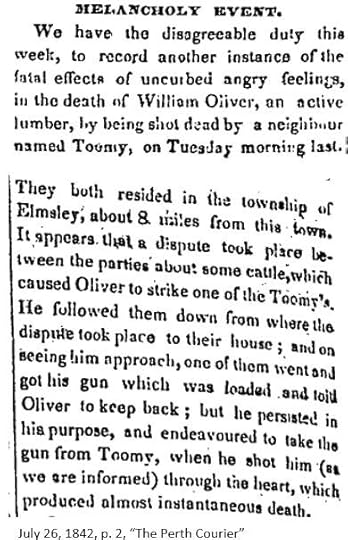
Rev. William Bell of Perth stated, “The tragical death of William Oliver, at the Rideau Ferry on the 19th, creating at this time a universal thrill of horror. It was dreadful to think of a man so profanely wicked as he was, being sent into eternity in a moment.”
Word spread quickly through the county, and on July 20, Peter Sweeney, Lockmaster at Jones Falls, noted in his diary “I heard that Mr. Oliver was shot by a neighbour at Oliver’s Ferry.”
“On Wednesday morning, July 20, 1842, an inquest was held upon the body, before W.P. Loucke, Esq., Coroner, when the Jury returned a verdict of Manslaughter against William and John Toomy, the evidence being contradictory as to which of the brothers had committed the deed. We understand they were sent to Brockville jail, to await their trial.”
“The Perth Courier”, July 26, 1842, p. 2
The Toomy brothers were jailed and both later convicted of manslaughter.

Oliver’s Ferry – Rideau Lake, 1834 – Archives of Ontario
One local legend passed down through the generations states that when the Oliver family’s buildings were torn down to make way for the new bridge built across the narrows in 1874, human bones were found both inside of the walls and under the floor boards.

Oliver’s Ferry 1828 looking south This shows the south shore where the Oliver family’s house was located (in red)
The bottom shows the north shore and the road to Perth. from: 1828, Scottish Records Office
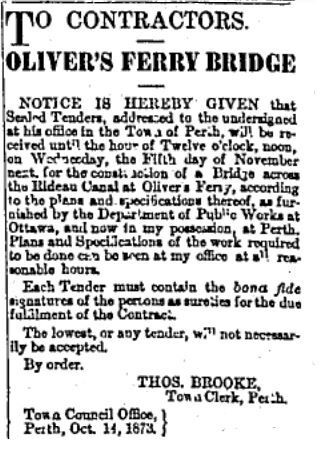
“The Perth Courier”, October 17, 1873, p. 4
Human Skeleton
Discovered
In 1873, when bids were being submitted on the contract to build a bridge to replace the ferry there was an alarming article in the local newspapers stating that there was:
“a discovery of a human skeleton under the platform of a house
near the wharf that was undergoing repairs.”
After the bridge was completed in 1874, there was no longer a need for a ferry service.
Both the original ferryman, John Oliver, and his son, William were gone – the father, by a self-inflicted gunshot, and the son, shot through the heart by his neighbour.

The legend of Oliver’s Ferry is one that’s been passed along for over 200 years, since 1821, and the unsettling death of John Oliver. His son William’s tragic demise adds to the mystery and intrigue of this fascinating tale!

Who were the travellers staying overnight at the Oliver’s home, and were they ever seen again?
Did authorities identify the human skeletons found under the wharf when they were building the Rideau Ferry bridge?
This fascinating story of the Oliver family remains one of Rideau Ferry’s dark legends!

Arlene Stafford-Wilson
Honorary Life Member, Lanark County Genealogical Society
Member, Association of Professional Genealogists
Author of : “Lanark County Kitchen”, “Lanark County Christmas”, “Lanark County Comfort”, “Lanark County Collection”, “Lanark County Calling”, “Lanark County Classics”, “Lanark County Connections”, “Lanark County Calendar”, “Lanark County Chronicle”, “Lanark County Kid”, & “Recipes & Recollections”.
“Revelry and Rogues on the Rideau”, a story in “Lanark County Chronicle”, tells the tales of John Oliver, and of Coutts House and the Rideau Ferry Inn, and of Al Capone’s rum-running days, and a secret tunnel built so he and his men could escape from their hideaway and cleverly evade the local police.
